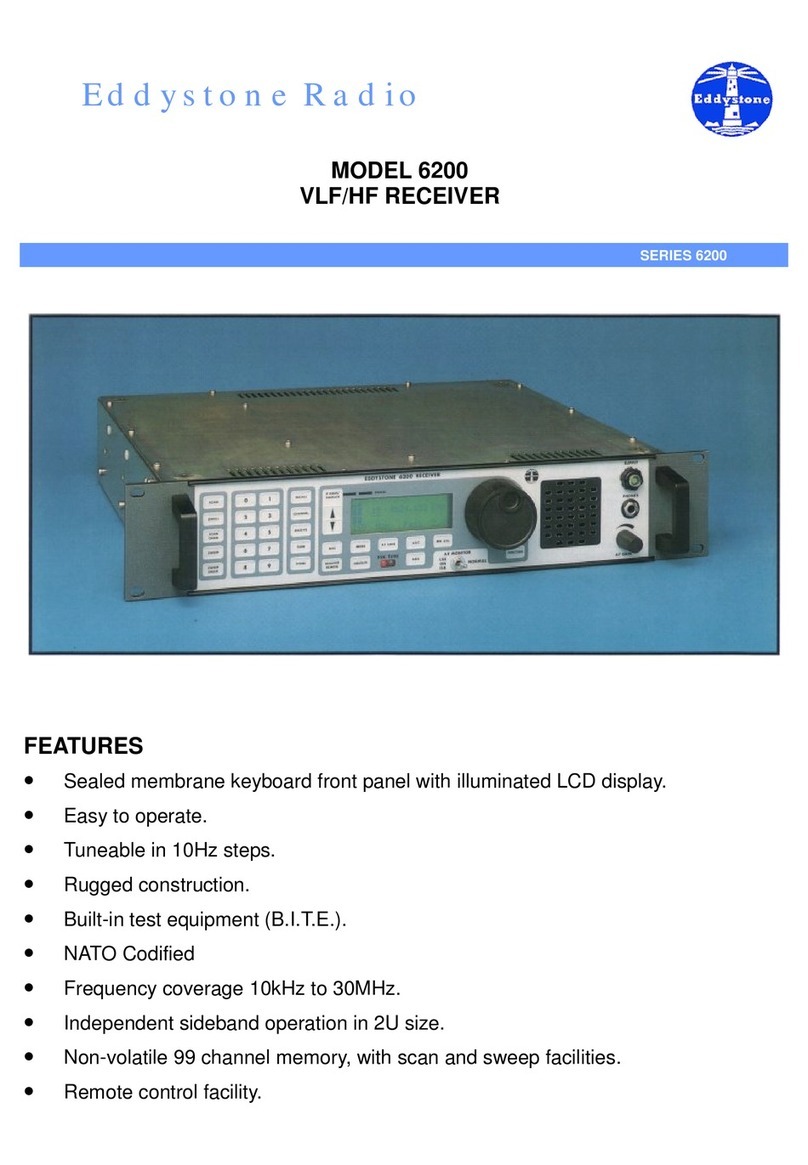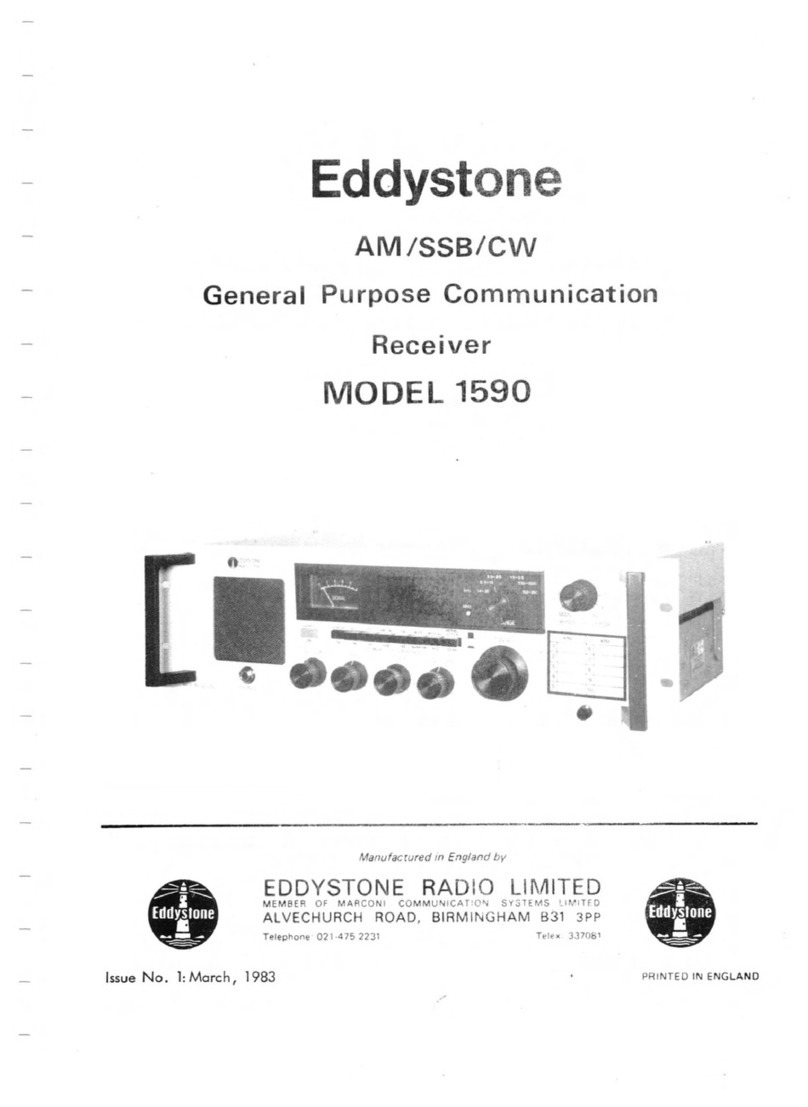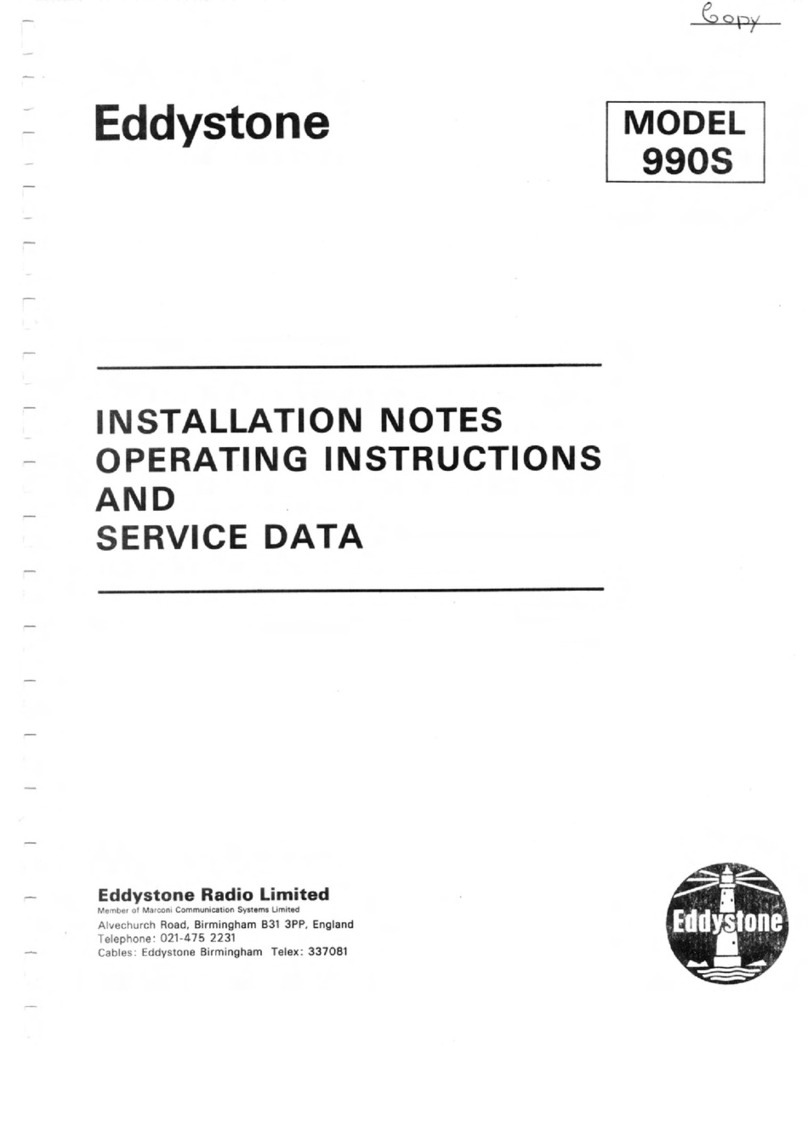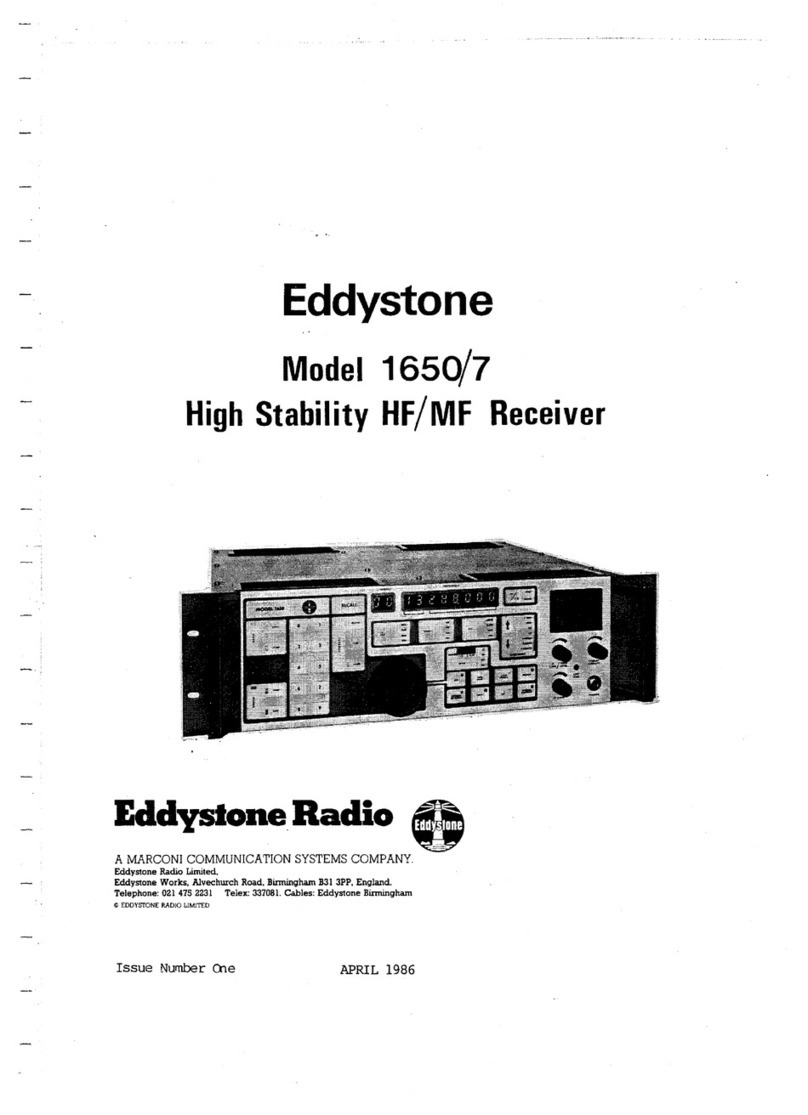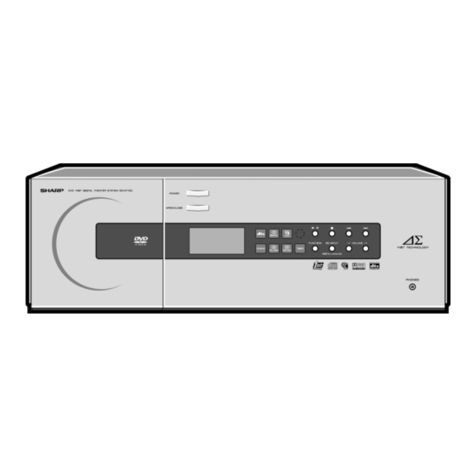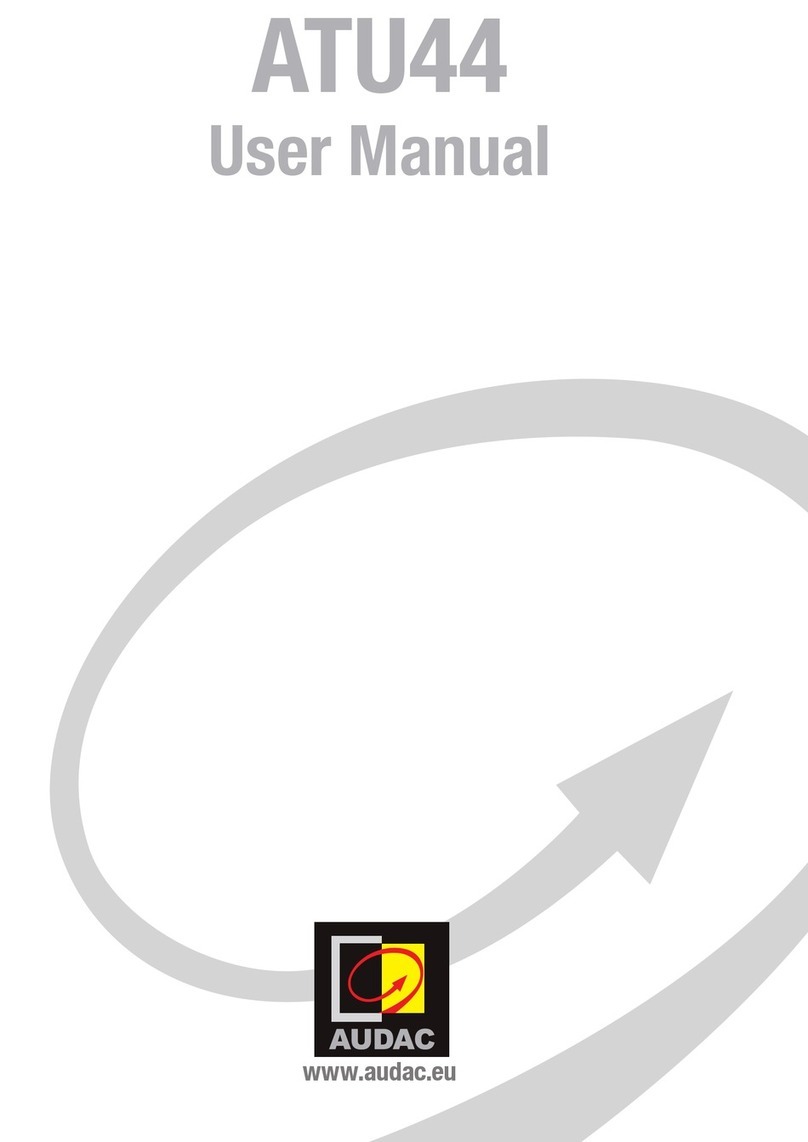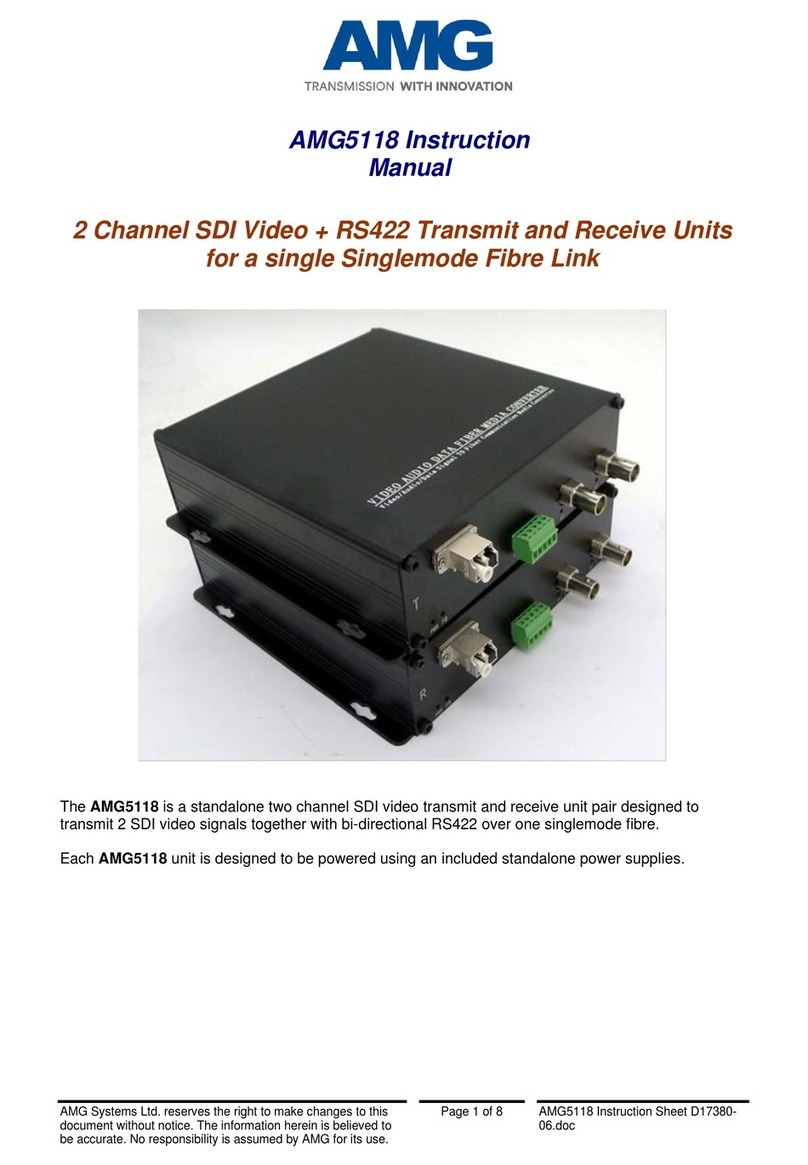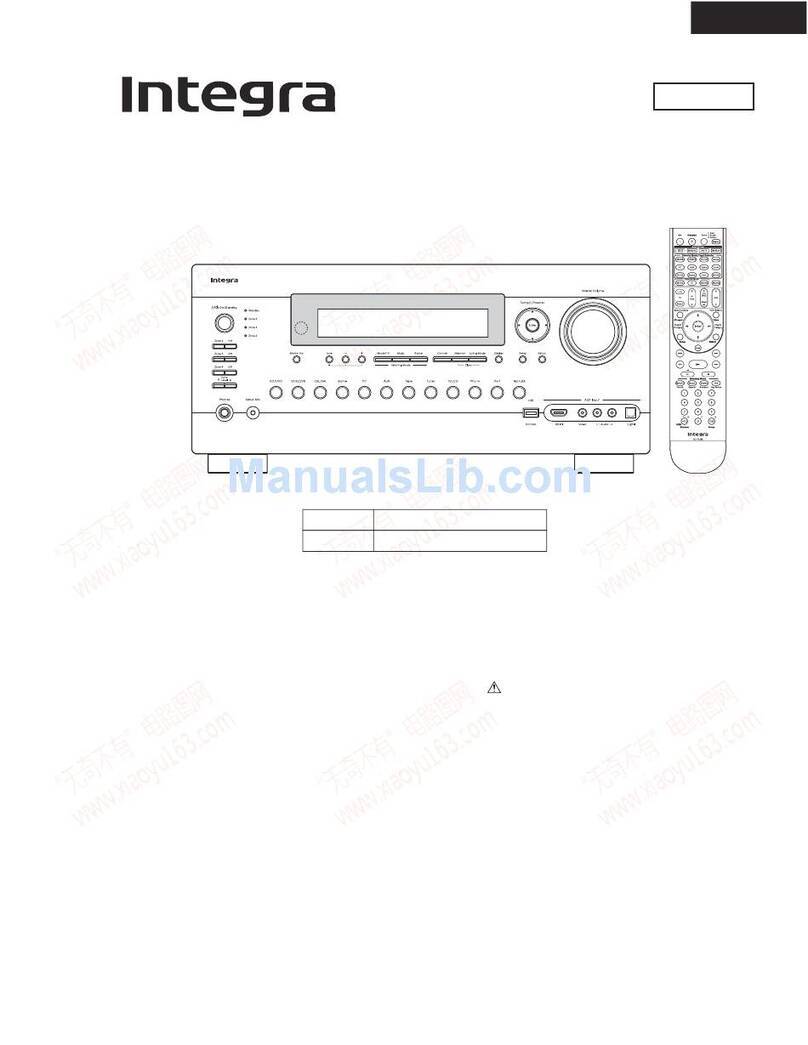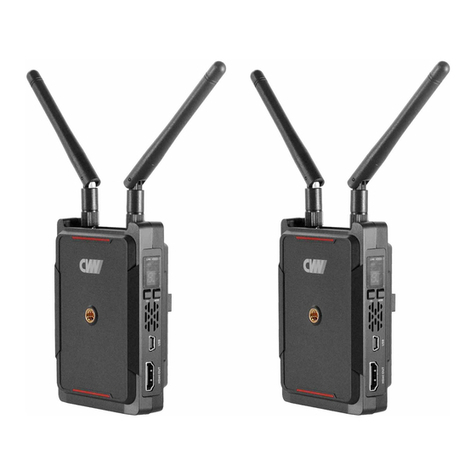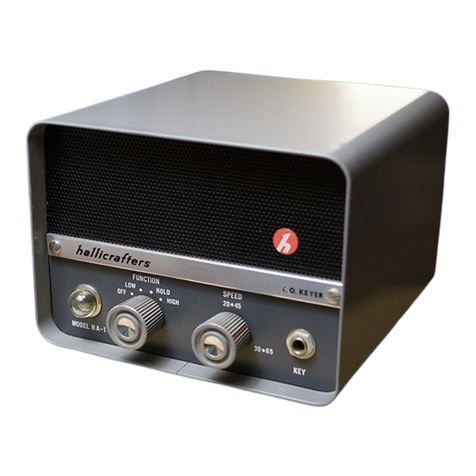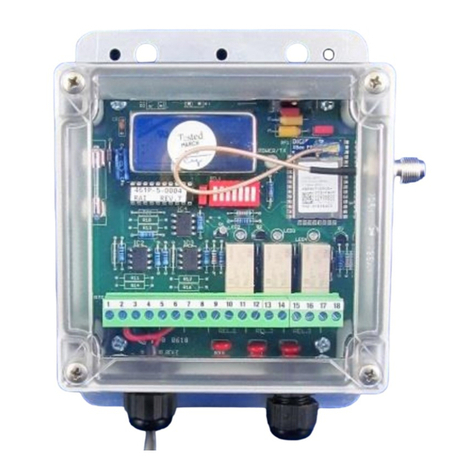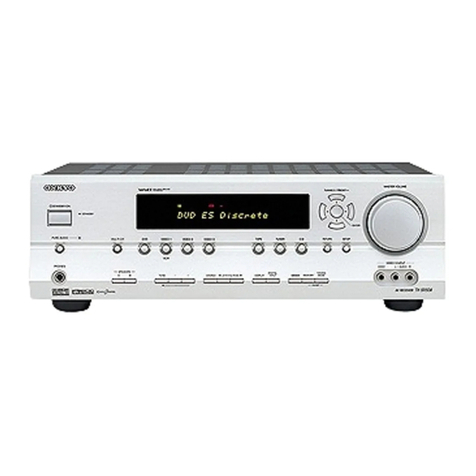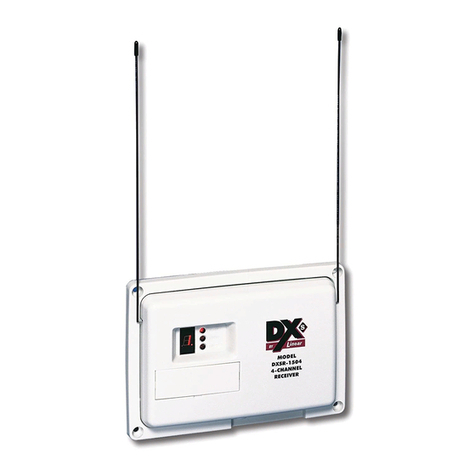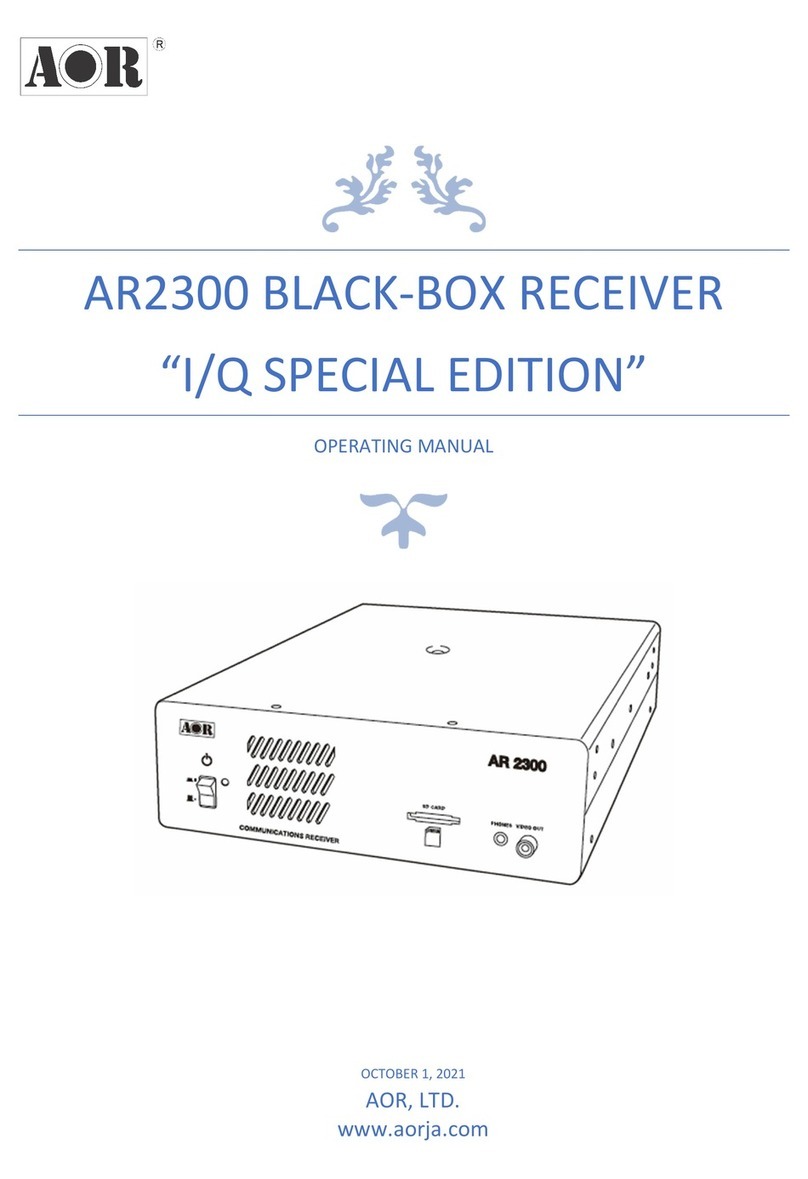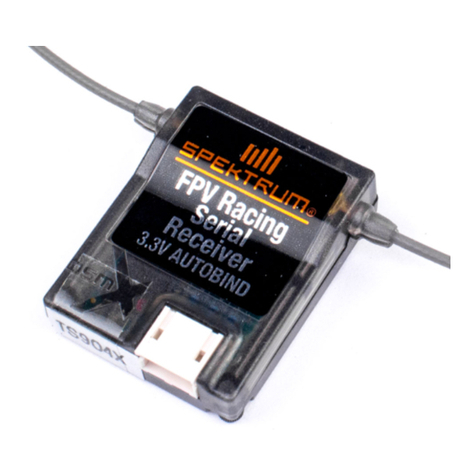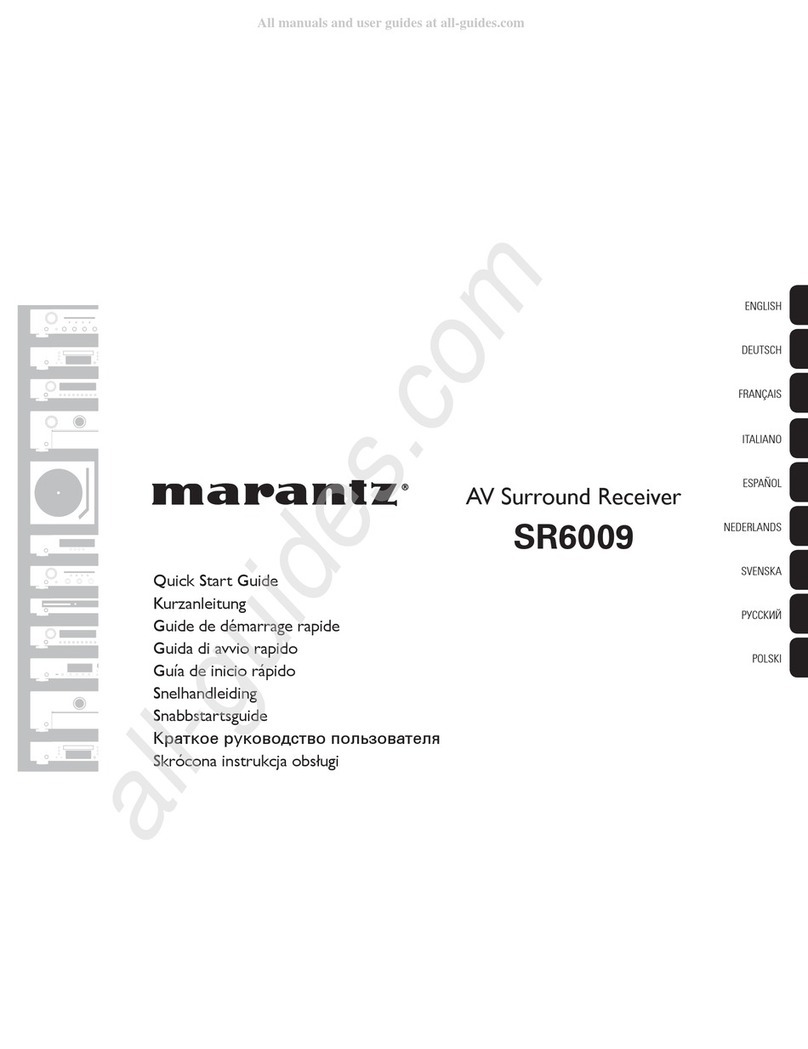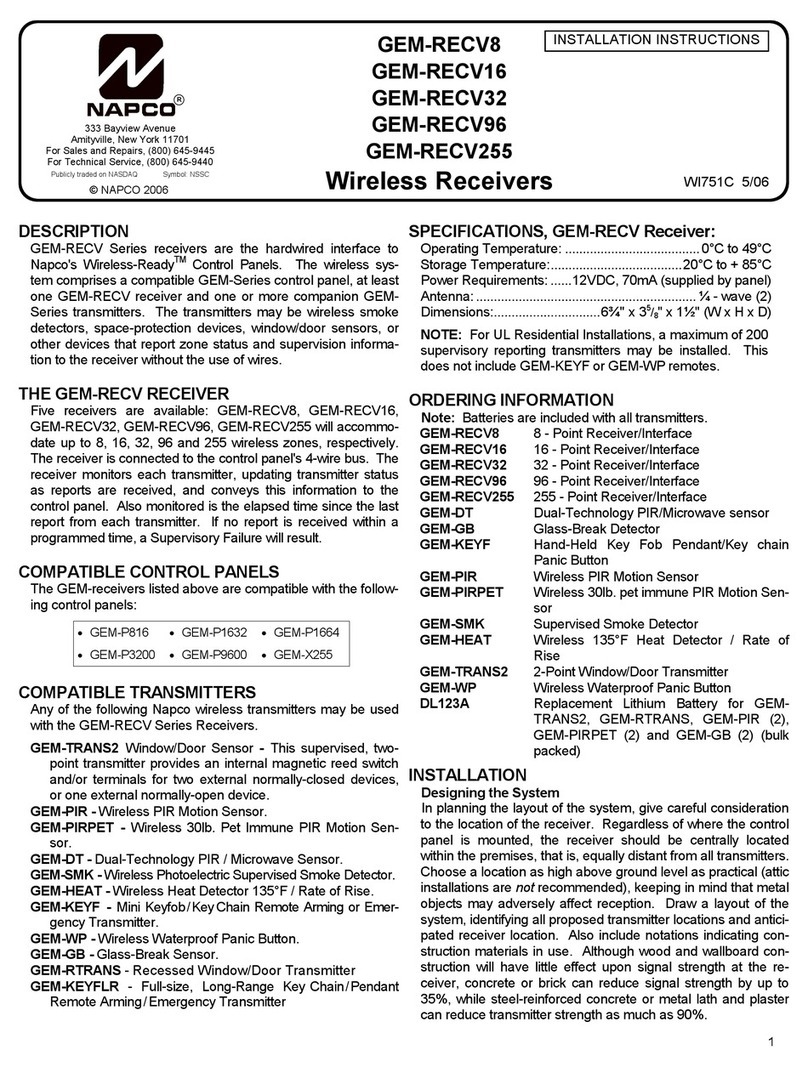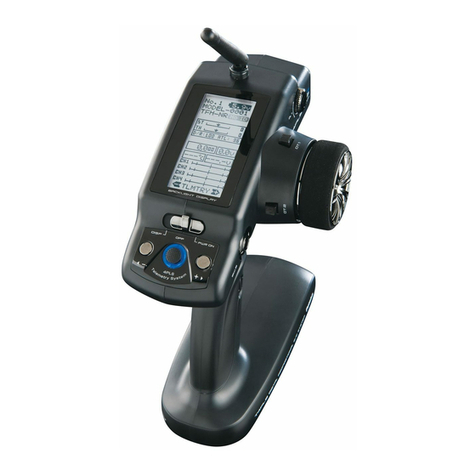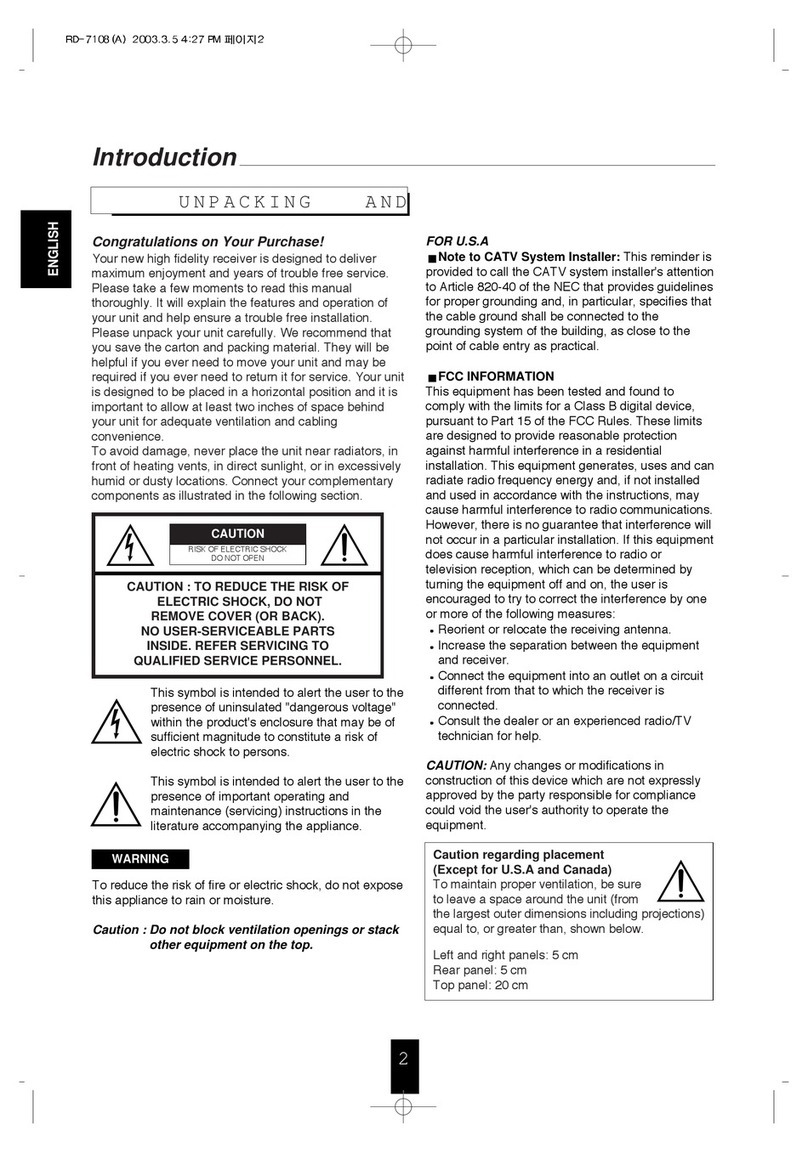Eddystone Short Wave User manual

SHORT WAVE RECEIVERS AND TRANSMITT

EDDYSTONE
SHORT WAVE MANUAL
No. 5
All the sets and equipment described in this Manual have been subjected to thorough tests and trials and can
be relied upon to give excellent results, if built exactly to the instructions given. Should difficulties be ex-
perienced, other than from faulty construction or the substitution of different components, we shall be glad to
help, but to avoid lengthy correspondence, we ask constructors to make a careful check of the equipment before
writing us. Finding out the cause of one's own troubles is, moreover, not only a reason for self-satisfaction
but is also highly instructive.
" Eddystone " components are available through selected Registered Retailers in most areas. In case of any
difficulty, you are invited to write for the name and address of your nearest stockist.
CONTENTS
BAND -SPREAD ALL DRY FOUR RECEIVER .. Page i
V.H. FREQUENCY METER ..
. . I3
SIXTY MEGACYCLE. xs WATT TRANSMITTER ,.
R5
9 f
FIVE -TEN METRE. 5 -VALVE CONVERTER .. , f io
TWO VALVE PRE -SELECTOR .. .. .. ..91 ,xl
28 MEGACYCLE C.W. AND TELEPHONY TRANSMITTER.. .. is
COMPONENT LIST AND PRICES .. .. Inside Back Cover
INT. OCTAL .
VALVE BASE DATA
B 9 G. AM. 7 PIN.
OCTAL BASED VALVES.
MSHDGiG2G3AK
Metallising.
Shield.
Heater.
Diode.
Control Grid.
Screen Grid.
Suppressor Grid.
Anode.
Cathode.
Valve Pin 1234567
H
H
8
K
Top Cap
EF 36
EF 39 M
-
HAG2 G3 -GI
L63
EC31 HA-GI K-
EL35
EL37
6V6 MHAG2 GI H
GI
HG3
H
HG3
K(G3) ---
0VO4-20
DF33
HGI
H
K, G3, S G2 H.C.T. Connect to
Shield H
Cl
--
A
-
GI-
AG2 -
DAC32
DL35
HA-D
HAG2 G1
BRITISH 9 -PIN BASED VALVES.
Valve
EF 50
EF 54
EC 52
OVO4-7
1
H
H
H
H
2345 6
K
GI-
7
GI
S
--
GI
8 9
G2 A G3 S S
S
--
S
H
AG2 K, S. G3 S H
GI K.A -H
AG2 G2 SKH
AMERICAN 7 -PIN BASED VALVE.
Valve 123 4
I
5 6 7 Top Caps.
4074A HGI K
I
GI HA


2EDDYSTONE SHORT WAVE MANUAL
in the rear of the cabinet to allow the aerial to be
connected when cabinet and chassis are assembled.
WIRING.
The wiring throughout, except for the screened
lead to V3 and possibly the battery leads, may be
carried out with 20 s.w.g. tinned copper wire en-
closed in insulating sleeving. All R.F and detector
circuit wiring must be kept as short as possible and
this point applies very particularly to the top grid
of the DAC32 detector valve. Both the grid con-
denser C8 and the grid leak R5 should be soldered
extremely close to the top cap - otherwise static
hum and other undesirable effects may be en-
countered.
The top cap of Vi and the stator of CI are
connected to a tag on the midget insulator, from the
underside of which A. wire is taken through the
chassis to pin 4 of the coil base.
Similarly, the grid condenser C8 and the
stat9rs of both C2 and C3 are connected to the other
midget insulator and detector coil socket. All
tuning condensers are earthed with short leads from
the tags provided to tags fitted under the bracket
bolts.Resistors Rio and Rig and condenser Cm are
soldered to the group board and the associated inter-
connections made before the board is fixed to the
rear of the chassis. The other small components are
held in the wiring, 5 -way tag strips being fixed on
available projecting bolts, for anchoring purposes and
to enable H.T wiring, etc., to be commoned up.
C4 and Cie are soldered directly from the appro-
priate valve pins to an earth tag, and condensers
C5 and C7 similarly from the detector coil base.
The double pole switch connects the L.T and
H.T batteries simultaneously. If a non self -shorting
telephone jack is employed, be careful not to dis-
connect the telephones whilst the set is working.
L.T leads are taken up through the chassis from the
switch and a chassis earthing tag and H.T leads
from the switch and the right hand tag strip to the
batteries clipped to the rear of the chassis.
Fig. 2. Illustrating the lay -out of the receiver. Due
to the addition of side brackets, it is necessary to trans-
pose the positions of the batteries.
Fig. 3. Showing the mounting of components on the
underside of the chassis.
OPERATION.
Before connecting the H.T battery, ensure
that the correct voltage is shown across the filament
pins (2 and 7) of any one valve, to avoid possible
damage through an inadvertent error in wiring up.
On advancing the reaction control from mini-
mum, a point will be reached at which oscillation
commences, indicated by the usual slight increase
in noise. The receiver is most sensitive when just
oscillating - advancing the reaction control too
far will cause violent oscillation. The R.F tuning
condenser should be kept in tune with the detector
stage - signals will increase in 'strength consider-
ably at the proper setting.
The frequency ranges, band -spread of amateur
bands, etc., are set out in the table below and close
agreement will be found in a receiver built to the
layout and instructions given above. In the case
of the 6BB coils; oscillation ceases at approximately
28° on the band -set dial, due to the inductance
capacitance ratio becoming too low but there is
still an overlap with the 6LB coil, As will be seen,
the coverage is complete from approximately 35
Mc/s. to 990 Kc/s., using the six coils specified.
The amount of bandspread on each amateur band is
fully adequate and makes the receiver a pleasure to
handle. The noise level is extremely low and weak
signals can be tuned in, held and read with ease.
An earthing terminal, on the rear of the chassis,
will be an asset but, to be effective, the earth lead
itself must be short, particularly when the receiver
is being operated on the higher frequencies.
The aerial employed will, of course, depend upon
local circumstances. For general use, a wire of a
length between 5o and too feet, suspended as high
and clear as possible, connected directly to the aerial
socket, will prove very effective on all ranges. For
restricted frequencies, e.g., any one amateur band,
an aerial cut specially to the appropriate length and
fed to the receiver by either low or medium im-
pedance feeder will ensure particularly good recep-
tion on that particular frequency band, although
directional effects may be noticeable.
The consumption from the batteries is very
low - 25 amperes L.T and 8.5 milliamperes H.T.

EDDYSTONE SHORT WAVE MANUAL 3
PANEL OF FREQUENCIES.
Frequency Range Amateur Bands. Frequency Range Amateur Bands.
Coil. Coil.
Max. Min. Band Set Frequency Band Max. Min. Band Set Frequen Band
Mc/s. Mc/s. Dial. Kc/s. Spread Mc/s. Mc/s. Dial Kc/s. Spread
Dial. Dial.
6 BB 35.6 27.2 18° 30000 15° f6 It 8.8 3.65 13' 7300 30°
(28°) 28000 89° 7000 60°
6 LB 27:4 12 680 14400 15° 6 W 4.65 192 13' 4000 0°
14000 88° 3500 100'
6 Y I15:85 7.05 6 P 2.45 99 16° 2000 10°
1800 90°
CHART OF POSITIO
CHASSIS (looking at front).
Top Chassis Screen 5' high, 7' long plus 1"
fixing flange, mounted 64' from L.H.
side, 94' from R.H. side, fixing flange
on right.
Sub Chassis Screen 2" high, 7' long plus 1"
flange, mounted 710 from R.H. and 84'
from L.H. side.
Adjustable brackets all 24" from front
(fixing centres). R.F. condenser
bracket 2' from L.H. side, detector
bracket 3' from R.H. side, Band spread
bracket 14" to right of- s!*een (i.e.,
dead central). All condensers 24 up
from chassis top.
NS OF MAJOR COMPONENTS, DIMENSIONS, ETC.
V.4 valveholder
from front. lir from R.H. side, 34" R.F. Gain Control 6' from L.H. edge (2' dia.
hole).
V.3 valveholder
from front. 11- from R.H. side, If" Switch 31' to left of R.F. Control (1" dia.
hole).
V.2 valveholder
from front. 51' from R.H. side, ir Jack 31' to right of Reaction Control (
dia. hole).
V.1 valveholder
from front. 51' from L.H. side, 11" Aerial Socket 5" from L.H. side.
1 General Purpose Chassis Eddystone No. 641
1 General Purpose Cabinet .. 609
2 Metal Handles 8' .608
2 Microdensers, 100 pF (Cl. 3) .. 1130
1 Air Dielectric Trimmer, 15 pF (C2) 580
1 Full Vision S/M Dial
2 Precision S/M Dials, 2" Silver ..
2 6 -pin Coil Bases ..
2 6 -pin Coils, 6BB
2 6 -pin Coils, 6LB
2 6 -pin Coils, 6Y
2 6 -pin Coils, 6R
2 6 -pin Coils, 6W
2 6 -pin Coils, 6P
1 R.F. Choke ..
2 Skirt Knobs 11'
3 Large Flexible Couplers
598639964959959959959959959
1010
2416
1009
R.F. coil base 54' from L.H. side, 34' from
front.
Det. coil base 54' from R.H. side, 31" from
front.
(Both are fitted with pins 1 and 4 to the
right).
Reaction control 6" from R.H. edge (1' dia.
hole). LIST OF PARTS.
3 Adjustable Insulated Brackets .. 1007
2 Midget Stand-off Insulators .. 1019
1 Valve type DF 33 (V1) Mullard
2 Valves type DAC 32 (V2, 3) .. Milliard
1 Valve type DL 35 (V4) Mullard
4 Octal Ceramic Valveholders.
1 Intervalve Transformer 3.5: 1 Niclet Varley
1 D.P.S.T. Toggle Switch, S.88 Bulgin
1Insulated Closed Circuit Jack .. Igranic
1 Aerial Socket type L373/Skt. Belling -Lee
1 Aerial Plug type L.373/P.8 Belling -Lee
3 Mica Condensers :001 mF (C4, 5, 13).
2 Mica Condensers -0003 mF (C7, 12).
1 Ceramic Condenser, 100 pF (C8).
1 Ceramic Condenser, 20 pF (C15).
1 Paper Condensers -5 mF (C11).
1 Paper Condenser -01 mF (C9).
PANEL.
Three 4' holes for dial bosses, plus two 4BA.
holes per dial, vertically above and
below large hole and 1 r apart. Holes
for jack, switch and potentiometers as
for chassis. Aerial socket and earth
terminal holes at rear of cabinet.
2 Paper Condensers -1 mF (C10, 14).
1 Electrolytic Condenser 8 mF (C6)
1 Resistor, 4 watt, 5,000 ohm (R3).
2 Resistors, 4 watt, 1,000 ohm (114, 12).
2 Resistors, 4 watt, 2 megohm (R5, 9).
1 Resistors, 4 watt, 50,000 ohm (R6).
2 Resistors, 4 watt, 20,000 ohm (R2, 8).
1 Resistor, 4 watt, 100,000 ohm (RIO).
1 Resistor, 4 watt, 10,000 ohm (R11)
2 Potentiometers, 100,000 ohm (RI, 7).
1 x 5 -way Group Board ; 3 x 5 -way Tag
Strips.
NOTE.-The stated values of resistance
are not critical and the nearest preferred
value, 20% tolerance, will be suitable.
V.H. Frequency Meter
INTRODUCTION.
Some method of measuring the actual operating
frequency is essential when working in the five metre
amateur band. The frequency meter described
below fulfils this function and it also has several
other uses which render it a valuable addition to any
amateur station. It illustrates one use of the small
diecast metal box - No. 65o - for which many
other applications can be found.
Basically, the instrument is of the absorption
type but with the addition of a valve and meter,
which combination gives a more positive and reliable
indication than is possible with the flashlamp bulb
usually employed. This latter method calls for
power to light the lamp and results in very flat tuning,
which drawbacks are absent in the present design.
CIRCUIT.
Referring to the complete circuitdiagram shown
in Fig. I, Li, CI, and C2 form the tuned circuit,
the 6o to 56 megacycle range being covered from 19
to 45 degrees of the dial. Coupling to it is accom-
plished by taking a lead from a point on the coil one
turn from the earthy end to a midget lead -through

4EDDYSTONE SHORT WAVE MANUAL
insulator, to the external terminal of which a short
pick-up rod is fitted.
Connection to the valve is made from an
approximate centre tap on the coil via a to pF
ceramic condenser, thus keeping the tuned circuit
loading low. The indicating meter, a Hobut minia-
ture type reading up to Soo micro -amperes, is shunted
across the valve with a Cat. No. tot I choke in series.
Two versions of the meter have been tested.
The one shown in the photograph, Fig. 2, utilises
a type 1T4 miniature 1-4 volt filament valve (Mullard)
used as a diode with all electrodes, other than the
filament, strapped together. The use of this valve
enables a small cell to be included within the box,
making the instrument completely self-contained.
The circuit employed is given in Fig. i(a).
Improved results are obtainable if a television
type diode (Mullard E.Ar5o) is substituted for, the
1T4, but in this case, it is not possible to include a
heater battery inside the box. Two terminals, one
insulated, are fitted to the lid of the box for con-
nection to an external L.T. supply which may con-
veniently be a 6.3 volt supply from a mains trans-
former indoors and three or four small dry cells in
series for use outdoors. The circuit in this case
becomes the one shown in Fig. t (b).
CONSTRUCTION AND WIRING.
Enclosing the instrument in: the Cat. No. 65o
metal box, which is complete with a close fitting
flanged lid, assists in the maintenance of frequency
stability and calibration and eliminates the effects
of body capacity and other unwanted external
influences. Because of the restricted space, the
components must be located with care, otherwise
the construction is straightforward.
The II" hole for the meter is located 1" from
the left hand side and t i" from the top, looking at.
the face of the box.
The tuning condenser requires a '4" hole 1" from
the right-hand side and t 14" from the top. The
switch is fitted to the left-hand top corner of the box,
near the lid, so that it is clear of the meter terminals.
Immediately below the meter is a midget insulator,
to a tag on which are anchored condenser C3, one
end of the RF choke and the wire to the valve anode.
FIG .I (a).
Circuit diagram of VHF Frequency meter employing
a 1T4 1.4 volt valve.
The aerial insulator is mounted through the top
side, 1" from both side and front, a -" hole being
necessary. The small index strip for the dial should
be fixed at an early stage in the construction. A
small metal strap holds in place the filament cell.
When all holes in the box have been made, first
fit the valve -holder in place. It is located 2i" from
each edge and as close to the face of the box as pos-
sible. Two I" 6 BA bolts with spacing pieces keep
the valve -holder away from the metal side. Loose
leads should be soldered to the valve pins (in the case
of the IT4, the GI, G2, and anode pins are corn-
moned) for connection to the appropriate points
later. The other components are then mounted,
leaving the coil until the valve and meter wiring has
been completed. The coil, directly across the pins
of which is connected C2, is soldered to one stator of
the variable condenser and to an earthing tag bolted
to the side of the box. Finally, C3 and the aerial
lead -through connections are completed.
CALIBRATION.
Before calibration, ensure that the lid is screwed
down and fit a 12" length of stiff copper wire to the
external terminal of the midget insulator. If
assistance is available from amateurs using trans-
mitters of known frequency, calibration can be
carried out quickly. Otherwise it will be necessary
to use an existing transmitter, or build a small
oscillator, with which to excite a Lecher wire system.
Space does not permit of a full description of this
method here and the reader is referred to the " Eddy-
stone " Ultra Short Wave Guide (published before
the War) and to the R.S.G.B. Amateur Radio Hand-
book. The frequency meter itself may be employed
to determine the position of the antinodes along the
Lecher wires.
When a number of dial readings against fre-
quencies have been secured, a graph should be drawn
and kept for use with the instrument.
USING THE FREQUENCY METER.
To measure the frequency of a transmitter, the
box, with its pick-up rod in position, is placed some
little distance from the output tank, and the dial
rotated slowly, since the tuning is quite sharp. If
Continued on page 9
-11C3 RFC
CI C2
TT 111LT
FIG.I (b).
VI
aim
74
Circuit diagram of instrument when using a
television type (6.3 v heater) diode.

EDDYSTONE SHORT WAVE MANUAL
60 Megacycle 15 Watt
INTRODUCTION. .
Several considera-
tions have been borne in
mind when designing a
transmitter for use in the -
6o megacycle amateur
band. Firstly, something
better than the simple .
self-excited oscillator, with
its inherently poor fre-
quency stability and liabil-
ity to frequency modula-
tion is definitely desir-
able. Secondly, too
elaborate a " line-up " hag
been avoided and the trans-
mitter described is capable
of giving good results without
adjustments.
A suitable modulator is included, together with
the necessary power supply for working off A.C.
mains, the whole forming a complete transmitter
on one chassis.
CIRCUITS.
The complete circuit diagram is given in Fig. 1.
The radio frequency circuits, of the balanced push-
pull type, are built around two type 4074A twin
triode valves, which are designed for use at very high
frequencies and are capable of realising high efficiency.
At the same time, the power requirements, both
L.T. and H.T. are economically low. The trans-
mitter is nominally rated at 15 to 20 watts input, the
R.F. output being between io and 12 watts.
The first 4o74A valve is employed as a self-
excited master oscillator in a somewhat uncon-
ventional circuit which requires only one tuning
control and which, in practice, functions well. The
frequency stability is good, sufficiently so in fact,
to enable the use of C.W. in a particular manner,
of which details are given later. The full high
tension voltage is not required on the first stage
and the surplus is dropped through R5. A closed
circuit jack (J3) enables a meter to be plugged in to
read the anode current of this stage. The master
oscillator produces more R.F. voltage than is
necessary to excite the power amplifier, and this
factor enables the loading to be kept low, with a
consequent improvement in frequency stability.
The second 4074A valve acts as a balanced push-
pull Class C power amplifier with a somewhat
higher L/C ratio in its anode circuit than is employed
in the master oscillator. A o/too "Millimeter is
permanently wired in the anode circuit. Neutralisa-
tion is effected by Cat. No. 481 Neutralising Con-
densers, mounted symmetrically in easily accessible
positions.
Bias for the M.O. valve is obtained through
separate resistors and for the P.A. valve through a
RFC.I
4
1.1 v --1J3
412 C
RI R3
c;IL
`T .T
calling for critical
RS
nG.1.
Transmitter
RI2 18
.T
s.
SI
R2 C 2 0
.T
combination of resistors. Whilst not essential, a
certain amount of fixed bias, obtained from a battery,
is advisable on the P.A. valve and the jack (J2) may be
employed for the connection of this additional bias.
This jack is primarily included to enable measure-
ment of grid current to be made, this being necessary
when neutralising the transmitter. The resistor in
the cathode circuit of the P.A. valve is normally
shorted out when the transmitter is functioning
properly but it is included for use during tuning
operations and for the,' special method of C.W.
operation.
The modulator conforms to standard practice
and, as shown in Fig. 1, is intended for use with a
crystal type of microphone. If a moving coil micro-
phone is employed, a suitable coupling transformer
must be included. If a carbon microphone is used,
the second valve may be omitted, in which case of
course, the anode of the first valve will be coupled to
the grid of the output valve.
The first two stages in the modulator use triode
valves, the first a medium impedance type and the
second a low impedance type. The beam power
output valve is capable of giving up to 8 watts audio
output, which is sufficient for full modulation of a
16 watt carrier. The switch S3 cuts off H.T. to the
modulator valves when C.W. is being used. The
correct output Toad of the EL35 valve is 2,500 ohms
and this is matched into the P.A. anode impedance
of approximately 5000 ohms by a multi -ratio. trans-
former.With the modulator and R.F. stages all on one
chassis, precautions are necessary to avoid R.F.
getting back into the modulator. Adequate filtering
is included so that no difficulty should be experienced
from this trouble.
The power supply also follows normal practice.
It uses the Mullard type FW4/5oo rectifier since the
total H.T. current consumption is in the region
of 15o milliamperes. When the transmitter is in
operation, all heaters are allowed to run contin-

EDDYSTONE SHORT WAVE MANUAL
uously and S2, which breaks the H.T. centre tap
to earth, is employed as a transmit/standby control.
GENERAL CONTRUCTION.
The transmitter is built on a standard chassis
Cat. No. 617, with a 8r front panel and two side
angle brackets, the whole forming a rigid unit of
pleasing appearance. Placing the transmitter,
modulator and power supply all on the one chassis
means that little space is wasted but no undue con-
structional difficulties will be experienced if the wgrk
is carried out in proper sequence.
The photographs Figs. 2, 3 and 4, show clearly
the lay -out which has been adopted, whilst the
chart, page 9, gives details of the spacings between
various components. It is suggested that a dummy
chassis top and panel are cut out of stiff cardboard
and all the components; screens, etc., laid out there-
on and the positions carefully marked. The card-
board pieces may then be used as templates for
marking out accurately the actual chassis and panel.
The Retailer from whom the items are pur-
chased may be in a position to assist the constructor
in the work of making the larger holes, otherwise the
help of a local metalworker should be engaged.
Note that the jacks and switches are fitted to the
front of the chassis and i" holes to give clearance are
required in the front panel. Two jacks (J2 and J3)
and two switches (S t and S2), being those which are
less frequently used, are mounted at the rear of the
chassis. The smoothing condensers take the form
of a three -in -one block, manufactured by British
Insulated Cables Ltd. This block mounts con-
veniently below the chassis to the rear, thereby saving
top space.
THE RADIO FREQUENCY STAGES.
Tandem construction, with the valves in a
horizontal position, permits an efficient lay -but with
an absence of long leads. To reproduce the excellent
Fig. 2. Top view illustrating the lay -out of the
transmitter.
Fig. 3. Close-up view of oscillator stage.
results given by the prototype this layout should be
followed closely, for which purpose a close-up view
of the master oscillator stage is shown in Fig. 3.
The M.O. valveholder is fitted to its bracket'
with the cathode pin at the top. To each top corner
of the bracket is fitted a midget stand-off insulator,
employed as a lead -through to hold the grid con-
densers and associated wiring firmly in place. The
grid R.F. chokes are similarly held rigid by two
further insulators on the chassis, leads being taken
from the undersides to the grid resistors. The M.O.
tuning condenser is fitted to an adjustable bracket
and its associated tuning coil soldered directly on the
end lugs on the stator sections. One end of the
anode R.F. choke is soldered to the centre of the coil,
the other being taken to the top of a Cat. No. 564 red
lead -through insulator. The timing condenser
rotor is connected to the cathode pin of the valve
via a short piece of thick copper braid.
A 6" square brass screen holds the P.A. valve -
holder and the neutralising condensers, which are
themselves fitted to miniature stand-off insulators.
Two holes in the screen are necessary to enable
the grid connections to pass through to the neutralis-
ing condensers. The P.A. tuning condenser is
mounted on an adjustable bracket in a position which
brings it close to the valve top caps. As before, the
coil is soldered directly across the condenser and the
R.F. choke from the centre of the coil is held by a
midget insulator, from which a lead is taken to the
meter. Another red lead -through insulator carries
the H.T. supply through the chassis, an R.F. choke
(RFC2) and by-pass condenser (C7) being fitted as
closely as possible to this insulator to prevent stray
R.F. being carried below the chassis.
As a result of keeping the wiring short, the
insertion of the valves is a little difficult but this is no
real disadvantage since it is unlikely that the valves
will require changing over long periods. The valves
should initially be fitted in their holders before the

EDDYSTONE SHORT WAVE MANUAL
adjustable brackets are fixed in place and should it
become necessary at any time to change a valve,
the nut holding the tuning condenser should be
slackened off and the condenser itself gently lifted
sufficiently to give clearance for the removal of the
valve and the insertion of a new one.
Aerial coupling is effected by a single turn coil
of 18 s.w.g. wire, enclosed in sleeving and looped
around the centre of the P.A. coil. The ends of the
loop are soldered to a Belling -Lee coaxial aerial
socket, fitted to a brass bracket which, in turn, is
mounted on the angle bracket opposite the coil.
MODULATOR AND POWER SUPPLY.
The modulator valves are grouped together
near the master oscillator and the associated com-
ponents are arranged on group mounting boards
fitted beneath the chassis near the appropriate
valveholders. The power supply components and
the modulation transformer are fitted at the rear of
the chassis and mounting of them should be left to
the last, to allow the chassis to be easily handled for
wiring up. Details of this part of the construction
are clearly shown in the photographs.
WIRING.
To begin with, the M.O. and P.A. radio fre-
quency stages should be wired, followed by the group
boards and audio circuits and finally the power
supply circuits.
The cathode, one heater and the two blank pins
on the M.O. valveholder are all soldered to a tag
bolted on to the brass bracket. Condenser C4 is
soldered directly across the heater pins and a flexible
lead from the " live " heater taken through a hole in
the chassis. The other components associated with
this stage are then wired up.
The silver plated tuning coil, a Cat. No. 602 of
four turns, is soldered to the condenser lugs nearer
the M.O. valveholder and to the same lugs are soldered
stiff pieces of wire from the grid lead -through
insulators. Anode caps on short flexible leads are
soldered to the other condenser lugs. Note that the
anode connections are crossed over so that the grid
condenser goes from the grid of one triode section
to the anode of the other. The valve will otherwise
fail to oscillate.
The P.A. stage wiring is very similar. In this
case, an additional condenser is soldered across the
cathode pin and earth tag, and leads through the
chassis are required both for the cathode and live
heater connections. The tuning condenser rotor
is not earthed but is allowed to " float." The tuning
coil is one of five turns. It is again necessary to
cross over the connections between the anodes of
the P.A. valve and the neutralising condensers.
The chart gives details of the components
which are fitted to the group boards, No. t being the
board mounted on the side of the chassis and the
others numbered reading outwards from this. The
small components are of course fitted to the boards
before the latter are bolted in place below the chassis,
using spacing washers to prevent any possibility
of short circuits occurring. The wiring of the R.F.
stages can then be completed. If a suitable power
supply is available (one giving between 15o and
25o volts will serve) it will be well to give the R.F.
stages a preliminary test as outlined below, to ensure
they are functioning correctly.
Next the audio stages may be completed. The
majority of the components are already in place on
the group boards but some, R9, Rio and RH for
example, are held in the wiring and should be con-
nected with very short leads. The electrolytic
by-pass condensers are connected between the
appropriate valve pins and the nearest chassis
earthing point. The lead from the underside of the
red lead -through insulator to the modulation trans-
former should be of screened cable and likewise the
lead from the modulation transformer to the anode
of V5. The H.T. connections for the three modulator
valves are brought to a common tag from which
a by-pass condenser is connected to earth. From
this tag also a lead is taken to S3 via a radio fre-
quency choke.
Tags t and 6 form the primary of the modulation
transformer and are connected to the anode of the
EL35 valve and to H.T. via the switch S3. The
secondary tags, connected in series with the H.T.
supply to the power amplifier, are 7 and to. It is also
necessary to connect up the following tags :-
2 tO 5 ; 7 to 9 ; and to to 12.
The audio circuits may now be tested but,
before doing so, connect a dummy load - a high
wattage resistor of 5,000 ohms or near - across the
modulation transformer' secondary winding.
Finally, it only remains to mount and wire up
the mains transformer and smoothing choke. The
safety fuse fitted in series with the primary of the
transformer is fixed to the rear of the chassis, between
the two switches, a t ampere fuse being adequate.
Fig. 4. Under chassis view of the Transmitter.


EDDYSTONE SHORT
COMPONENTS LIST.
2 Air Dielectric Trimmers, 25 pF x 25 pFEddystone Cat. No. 583
2 Neutralising Condensers, 4 pF 481
7 R.F. Chokes, V.H.F. 1011
1R.F. Choke .. 1010
2 Adjustable Mounting Brackets 1007
2 Slow Motion Precision Dials, 2" Silver 639
2 Flexible Couplers, Large Size 1009
9 Midget Stand off Insulators 1019
2 Red Lead Through Insulators 565
1 U.S.W. Coil, 4 turns 602
1 U.S.W. Coil, 5 turns 603
1 Instrument Knob, ir 1089
I Chassis .617
1Panel, 8i" .. 620
1Pair Angle Brackets 618
I Mains Transformer, Outputs 300-0-300 v. 150 mA
6.3 v. 3 amp. 4 v. 3 amp. .. Woden
1 Smoothing Choke, 20 H., 150 mA .. Woden type C.S.P.12
1 Modulation Transformer ...Woden type U.M.1.
2 Valves (VI, V2), 4074A *Standard Telephones & Cables Ltd.
1Valve (V6), F.W. 4/500 Rectifier Mullard
IValve (V3) L.63 Osram
1Valve (V4) E.C.31 Mullard
1Valve (V5), E.L.35 Mullard
2 Valveholders, American 7 -pin Ceramic S.T.C.
3 Valveholders, Octal Ceramlf
1Valveholder, British 4 -pin.
1 Smoothing Condenser Block, 3 x 8 mF, 550 v. B. I. Ltd.
1Milliameter, 100 mA, Moving Coil .Weston
1 Microphone, D.104, Crystal .. Rothermel
3 Switches, S.P.S.T., S.81 .Bulgin
1 Fuse Holder and Fuse (1 amp.), L.1045, C3 Belling Lee
1 Panel Light Holder and Bulb D.19 Bulgin
4 Telephone Jacks, Insulated, Closed Circuit Igranic
2 Electrolytic Condensers 50 uF, 12v. (C16, 18).
1 Electrolytic Condenser 25 uF, 25 v. (C15).
2 Ceramic Condensers, 10 pF (C9, 10).
2 Ceramic Condensers, 40 pF (C11, 13).
8 Mica Condensers 0003 uF (C5, 6, 7, 8, 13, 14, 20, 24).
2 Tubular Paper Condensers, -01 uF (C17, 19).
2 Resistors, watt, 5,000 ohms (R6, 7).
2 Resistors, 4 watt, 500 ohms (R2, 3).
1Resistor, I watt, 50,000 ohms (R18).
1Resistor, watt, 100,000 ohms (R17).
1Resistor, watt, 1,000 ohms (R14, 16).
1Resistor, watt, 2,000 ohms (R15).
2 Resistors, watt, 10,000 ohms (R11, 13).
1Resistor, watt, 1 Meg. (R15).
1Resistor, 1 watt, 200 ohms (R8).
1Resistor, I watt, 250,000 ohms (R11).
1Resistor, j watt, 100 ohms (R10).
1Resistor, k watt, 12 ohms (R9).
WAVE MANUAL 9
1Resistor, Variable, 2 Megohm (R20).
2 Resistors, 5 watt, 1,000 ohms (RI, R5).
1Resistor, 1 watt, 1,000 ohms (R4).
1Resistor, l watt, 500,000 ohms (R19).
4 5 -way Group Boards.
1Aerial Coaxial Socket, L.373/Skt.
1Aerial Coaxial Plug, L.373/P.8
1 Mains Connector, P.31
Belling Lee
Belling Lee
Bulgin
NOTE. ---The resistance values given are not critical. All may be
of 20% tolerance and the nearest preferred size will serve
if the actual value specified Is not obtainable.
CHART OF
CONSTRUCTIONAL DETAILS & DIMENSIONS.
Details of dimensions, spacings, etc., of screens and components
used in the transmitter. Distances are from valveholder, etc.,
centres or from fixing hole centres in the case of items such as
adjustable brackets, etc.
CHASSIS (looking at front).
M.O. Valve Bracket 2" wide, 3" high plus 4" flange. Valveholder
central 14" up. Fixed 2" from R.H. edge, centre 31" from front.
M.O. Condenser Adj. Bracket fixed 24" from front, 6" from R.H.
edge. Screen 6" by 6" plus 4" flange. Fixed 8" from R.H.,
9" from L.H. edge flush to panel. Valveholder central 2)"
up. Midget insulators 24' up each side of valveholder.
P.A. Condenser Bracket (adj.) 4" from L.H. side, 2)" from front.
Midget Insulators (M.O. grid chokes), 3" apart, 1" from R.H. edge.
Midget Insulators (P.A. grid chokes), 3" spart, 4" right of screen.
Red Insulators M.O., 4" from R.H. edge, 5" from front.
P.A. 64" from R.H. edge, 14" from front.
V3, V4 valveholders 14" from front, 14" apart.
V5 valveholder 74" from front, 2" from R.H. side.
Jack holes diam., switch holes 4" diam., all 3" apart,
1" up from lower edge.
Hole for Mains Connector at rear of chassis 14" .< 4".
PANEL (looking at front).
5" x r clearance holes for jacks, switches, etc., 1" up from lower
edge.
4" holes for dials - M.O. 5" from lower edge, 7" from L.H.
P.A. 5" from lower edge, 5" from R.H. edge.
Meter 24" hole, 24" from top edge, 84" from L.H. edge.
DETAILS OF COMPONENTS ON GROUP BOARDS.
No. I. R6, C14, R7, R5.
No. 2. R14, R12, R8, C17.
No. 3. C19, RI5, R18, R17, R16.
No. 4. RI, R13, C8, R2, R3.
The details given above represent the order in which the
components are mounted, reading left to right, looking at the
front of the inverted chassis.
V.H. Frequency Meter
Continued from
only a small, or perhaps no reading is obtained, the
instrument should be moved nearer but care should
be exercised to prevent damage to the micro -
ammeter.No meter reading will be possible when measur-
ing the frequency of a receiver but indication will
be given in the manner normal to absorption type
meters - that is, cessation of oscillation at resonance,
or diminution of quench noise.
The meter may be used to indicate neutralisation
of a power amplifier. With H.T. removed from the
P.A. and the tank circuit tuned to resonance, a small
reading should be obtained on the frequency meter
when it is placed near and tuned to the transmitter
frequency. Adjustment of the neutralising con-
denser, at the same time swinging the tank con-
denser slightly to maintain resonance, should be
made, until no meter reading is obtainable.
If a transmitter with a fair amount of power is
employed, the meter can be used to measure quali-
tatively the radiation from an aerial system and to
show the effect of various degrees of aerial coupling.
The polar diagram and back to forward ratio of a
Page Four.
beam array can be determined and the positions and
lengths of director and reflector elements adjusted
for optimum radiation in the desired direction.
One further application of the frequency meter
is as a standing wave detector on open wire feeder
lines. If, on moving the aerial rod attached to the
meter along a feeder line, the meter reading fluctuates
considerably at regular intervals, it is a definite indi-
cation of the existence of standing waves along the
line. Further adjustments of matching, particularly
at the aerial end, should make it possible to reduce the
variations to a small amount - it will usually be
difficult to remove them completely.
COMPONENT
IAir Dielectric Trimmer 15 pF (CI )
1 Direct Drive, 2" Dial (Black) .
1U.S.W. Coil, 5 turns
1R.F. Choke (VHF) ..
1 Die-cast Metal Box with Lid
2 Midget Insulators ..
1Switch, SPST, type S.80
1 Meter 0-500 microamps
2 Ceramic Condensers, 10 pF (C2, 3)
1Mica Condenser -0003 mF (C4).
1Valve 1T4 or EA 50
1Valveholder,, as required.
1L.T. Cell, 1.5 volt.
LIST.
Eddystone Cat. No. 580595603
1011650
1019
Bulgin
IlobutErie
Mullard

10 EDDYSTONE SHORT WAVE MANUAL
Five Ten 3 -Valve Converter Unit
INTRODUCTION.
When used in conjunction
with ashort-wave receiver
(which may be either a T.R.F.
or superheterodyne, the very
high frequency converter des-
cribed below enables signals on
the 5 and to metre amateur
bands to be received. The
short-wave receiver may already
include the to metre band in its
coverage but it is likely that
both sensitivity and selectivity
may be poor at this extreme
range and the use of the' con-
verter will result in a much
better performance generally.
The super -regenerative type
of receiver has inherently low selectivity, is unable to
receive C.W. signals and is liable to cause serious
interference to other receivers and its use is therefore
deprecated. The converter unit suffers from none
of these defects and is capable of giving excellent
results with any type of shortwave receiver.
CIRCUIT.
The converter unit has been designed and built
around three modern valves, of a type which ensure
really good performance at very high frequencies.
As shown in the circuit diagram, Fig. 1, an EF54
(previously known 'as an RL7) single ended R.F.
pentode is employed as a tuned R.F. amplifier. It
will normally be operated at full gain but a variable
resistor (R2) is included to enable gain to be reduced
wren strong local signals are being received. This
system of gain control works quite well, even though
the EF54 valve is not of the variable -mu type. The
frequency changer is an EF5o, with suppressor
grid injection from the local oscillator, which employs
an EC52 (previously RLi6) triode. The tuned
circuit of the latter incorporates a fixed condenser in
parallel with the split -stator tuning condenser, which
arrangement results in adequate spreading of the
amateur bands. The R.F. and F.C. tuning con-
densers are ganged and controlled by a direct drive,
since tuning of these stages is not critical. Con-
versely, the oscillator tuning is sharp and a good slow
motion dial is essential.
Interchangeable coils are employed, three being
required for each band. The aerial input is arranged
for a coaxial feeder from a dipole aerial, although
other types may be used. The intermediate fre-
quency output, at 1.6 megacycles, is taken via a
short -length of coaxial feeder to the short-wave
receiver. An open wire should not be used or pick-up
of unwanted signals around 1.6 Mc/s. may occur.
CONSTRUCTION.
The converter is built on a diecast aluminium
chassis and enclosed in a metal cabinet. Very corn-
plete screening is essential and
therefore a certain amount of
metal work is unavoidable. As
shown in the photograph of
the top deck, Fig. 2, the
oscillator section is screened
off by apiece of metal
which should be as thick as
possible - preferably not thin-
ner than r8SWG -and arranged
to come flush with the front
of the chassis. The oscillator
condenser is mounted on a
metal bracket, the dimensions of
which, together with those of
other metal parts, is given in the
chart (page 12). The screen
beneath the chassis measures
9" by 2" and should be bent to shape and fixed so
that it screens off all components associated with the
R.F. stage from those of the other two stages.
Three small holes are required in this screen,
for connections to H.T., L.T., and the suppressor
grid of the EF5o. The latter hole should be made
immediately opossite the appropriate pin of the
EF5o valveholder, to enable the lead to be kept
separate from other wires.
The mounting of the gang condenser calls for
detailed explanation. It is not desirable to use in
this position a twin gang condenser with a common
spindle, since coupling between the R.F. and F.C.
stages will occur. Two Cat. No. 58o air dielectric
trimmer condensers are therefore employed, with a
medium size insulated flexible coupler. The con-
densers are held together by two brass rods, 4"
long and either Ar" or I" square, tapped 6 BA at
the ends and screwed to the spare holes in the
ceramic end plates. Two further tapped holes in
each rod enable the assembly to be fixed to the
chassis. Spacing pieces /98-" long are employed to
hold the condensers above the chassis, with the stator
plates uppermost. If tapping facilities are not
available, two 3" lengths of 6 BA screwed rod may be
used, with nuts and washers on both sides of the
ceramic plates. Small brass feet, for mounting
purposes, can then be located conveniently along the
rods and held in place with 6BA nuts.
The screen between the two condensers is
fixed to the rear condenser by the nut on the spindle
bush, two slots being cut out to take the brass rods.
The screen, which again should be of stout metal,
comes flush with the chassis. It projects slightly
over the edge on one side and is close against the
EF5o valve on the other side. Each coil holder
is fitted as close as possible to its associated condenser,
leaving a small clearance between the coil and the
condenser plates. The bracket holding the aerial
socket is fitted on the edge of the chassis and a single

EDDYSTONE SHORT WAVE MANUAL I
Fig. 1.
turn coupling of 18
the R.F. coil.
When fitting the chassis into the cabinet, it is
good plan to fit short extension spindles to the
flexible couplers, of a length to bring them level with
the gain control spindle. A spot of paint on the
end of each spindle will then leave an indication on
the inside of the cabinet front of the exact point at
which the appropriate holes should be drilled. A
hole I- diam. is required in the side of the cabinet
to give clearance to the aerial plug.
WIRING.
It is hardly necessary to say that in a V.H.F.
unit of this type, it is imperative to keep short all
R.F. wiring and particularly the wiring in the
tuned circuits. Also, loops in the wiring must be
avoided as far as possible - for instance, when
grounding several points, separate wires should be
used, each going to the same soldering tag on the
chassis, rather than one wire running from com-
ponent to component and thence to chassis.
To take the oscillator stage, the coil base is
lifted h-" above the chassis so that the soldering
tags come level with the condenser lugs. Short
wires through the chassis connect to the anode pin
and the grid condenser. The latter is supported on a
single insulated tag. R8 and C14 are soldered
directly across the appropriate valve pins, and C13
directly across the upper condenser lugs.
The frequency changer wiring calls for little
comment. The tag on the tuning condenser bush
is soldered to the " cold " end of the coil base and to
a tag fitted under the coil base fixing screw. The
positions of the other components associated with
this stage are clearly shown in Fig. 3.
The tag on the R F tuning condenser and the
cold end of the coil base are both soldered to a tag
bolted to the chassis. The other components are
grouped closely around the valveholder, insulating
tags being ..tmployed where necessary, to hold parts
rigid. Two R.F. chokes in series are necessary in
the anode circuit of the R.F. valve. The VHF choke
(RFCI) is held between the anode valveholder pin
and a single tag strip beneath RFC2 (which is visible
in the photograph) and is held by another tag strip,
to which R3 and C5 are also connected.
SWG wire is arranged close to
The power supply leads are brought together
to a tag strip bolted to the rear of the chassis. All
valve pins labelled " screen " and the tag on the
centre spring grip of the V2 valveholder are soldered
to a common earthing tag. In the case of Vi, the
screen is connected internally to the cathode and
the pins marked " screen " are left alone, but the
centre tag is earthed.
PUTTING THE CONVERTER INTO
OPERATION.
The converter requires 6.3 volts I amp. for the
valve heaters and 200/250 volts 3o mA (approx.)
H.T. supply. These may be obtained from the set
used with the converter (provided the mains trans-
former will not thereby be overloaded), from a
separate mains unit or from batteries. Smoothing
must be good, to prevent A.C. modulation of the
oscillator.
The output socket is connected to the aerial
input of the receiver, which should be tuned to 1.6
megacycles. If the receiver is a superhetrodyne
the B.F.O. will be used as usual for the reception of
C.W. whilst in a straight receiver, the detector stage
should be just oscillating. A suitable aerial system
should be connected to the aerial socket.
A low power oscillator, roughly calibrated, will
be found an asset in ascertaining that the converter
is working properly, particularly on the 6o Mc/s.
band, where, in some localities, signals may be rare.
On the 6o Mc/s. band, 3 turn coils are plugged into
the R.F. and F.C. coil sockets and a 4 turn into the
oscillator coil socket. The actual oscillator range,
over the full dial, will be 53 to 63 Mc/s. The
oscillator may therefore be used either 1.6 Mc/s.
higher or lower than the signal frequency - in the
latter case, the coverage will be from 51-4 to 6o-5
Mc/s. and the amateur band (58.5 to 6o Mc/s.) will
occupy from 6o to 48 degrees. Future possible exten-
sions of the band are also covered.
Fig. 2. The oscillator is to the left of the metal screen.
Front right is the frequency changer and rear right the
R.F. stage.

12 EDDYSTONE SHORT WAVE MANUAL
Fig. 3. Under -chassis view of the Converter. RFC2
is shown near the potentiometer and beneath it, but not
visible is RFC'.
The left hand smaller dial controls the R.F. and
F.C. tuning condensers and the noise level will
increase at resonance. The dial reading will be 5o°
approx. at 6o Mc/s. Whilst not critical, the tuning
of these stages must be kept in step with the oscillator
or signals will be missed. The coils, condensers and
stray capacities associated with the first two stages
are all similar and ganging is therefore fairly good.
Fine adjustment can be carried out, with the aid of a
steady local signal, by opening out or closing up one
of the coils, but this coil must then be marked so that
it is always put back in the same coil socket.
For use on the 28 Mc/s. band, three to turn coils
are plugged in. In this case, the oscillator covers
28 to 35 Mc/s. and is set 1.6 Mc/s. lower than the
signal frequency, giving coverage of from 26.4 to
33.4 Mc's. The band of 28 to 3o Mc/s. is covered
from 78 to 44 degrees on the oscillator dial, the R.F./
F.C. dial setting being in the region of 90 degrees.
All settings are, of course, approximate but close
agreement will be found providing the layout shown
is accurately followed.
The aerial coupling coil should be very close
to the tuning coil and, on 28 Mc/s1, it may be found
an improvement with some aerials to use two turns
instead of one.
CHART OF CONSTRUCTIONAL DETAILS,
(Looking at Front.)
Central Brass Screen 4" high, 51" long, with mounting flange
fitted 5' from L.H. edge, 31" from R.H. edge.
Oscillator Condenser Bracket, 1.4" wide, 11" high, plus flange.
Fitted from front, spindle 21' from R.H. edge, 14" up.
V3 (OSC) Valveholder 2' from rear, r from R.H edge.
VI (RF) Valveholder 11" from front, 31" from L.H. edge.
V2 (FC) Valveholder It" from rear, 31" from L.H. edge.
Condenser Screen 3' high, 31" wide. Condenser spindle 1/" from
L.H. edge, 14' up.
L4 Coil Base behind C12.
LI Coil Base alongside RF Section of Condenser (fixing hole r
from L.H. side, 21" from front).
L3 Coil Base alongside FC Condenser section (i" from L.H. side,
4" from rear).
Aerial Socket Bracket ir long, 1" high, plus flange, fitted flush
with L.H. side, centre 11" from front edge.
Lower Screen 2" deep plus flange, 9" long, bent to fit.
6 Mica Condensers-, -0005 mF. (C3, 4, 5, 7, 9, 14).
1 Mica Condenser, .001 mF. (C8).
1 Mica Condenser, -0003 mF. (C10).
2 Ceramic Condensers, 10 pF. (C6, 13).
1 Ceramic Condenser, 50 pF. (C11).
1Resistor, 4 watt, 220 ohm (R1).
3 Resistor, watt, 500 ohm (R3, 5, 7).
2 Resistors, watt, 5,000 ohm (R4, 6).
1Resistor, watt, 30,000 ohm (R.8
1Resistor, watt, 20,000 ohm (R9).
1Resistor, Variable, 5,000 ohm (R2).
2 Coaxial Sockets, type L373/Skt. Belling Lee.
2 Coaxial Plugs, type L.373/P.8 Belling Lee.
1x5 -way, 3 x1 -way, 1 x 3 -way Tag Strips.
COMPONENTS LIST.
1Die-cast Chassis .. .. .. Eddystone Cat. No. 643
1 Metal Cabinet -.
644
2 Air Dielectric Trimmers, 15 pF .580
.
1 Air Dielectric Trimmers, 25 x 25 pF 583
1 Vernier Slow Motion Dial, Silver 637
.
1Direct Drive, 2" Dial, Silver 638
.
3 Flexible Insulated Couplers, Medium Size .. 529
3 U.S.W. Coil Bases .. .. 606
.. .
3 U.S.W. Coils, 10 turns 605
2 U.S.W. Coils, 3 turns 601
I U.S.W. Coll, 4 turns 602
1 VHF. Choke (RFC1) 1011
2 R.F. Chokes (RFC 2 and 3) 1010
I Instrument Knob 11" 1089
1Valve, type EF54 (V1) Mullard
1Valve, type EF50 (V2) Mullard
1Valve, type EC52 (V23) ...Mullard
3 Ceramic Valveholders, 9 -pin British with with Locking rings.
Belling Lee.
28 Meg. Transmitter. CHART OF POSITIONS AND DIMENSIONS. Continued front page 20.
TRANSMITTER TOP CHASSIS.
Crystal Holder, 6" from left hand edge, 21" from fear.
VI Valveholder, 8" from left hand edge, 21" from rear.
V2 Valveholder, 5" from right hand edge, 21' from rear.
L3 Insulators, 11" apart, from rera.
L4 Insulators, 11" apart, 11" from right hand edge.
C13 Bracket, 11" wide, 21" high with i" fixing flange.
Mounted 2" from front. Condenser mounted 1r up.
V3 Screen, 11" (overall) by 51" high, plus 4" flange. Valveholder
11" up, 21" from front.
L5 Insulators, 3" apart, 3" from left hand edge.
Coaxial Socket Bracket, 3" x 11" wide, fixed to Angle Bracket.
1" holes for leads to heater and G2 of V3.
r hole for leads to anode current meter.
4" hole for P.A. H.T. lead through insulator.
1" hole beneath Insulator for G.B. negative lead.
4" holes beneath L3 Insulators.
TRANSMITTER UNDER -CHASSIS AND PANEL.
Brackets for C3, C4 and C10, 2" wide, 11- high plus 4" flange.
Jack mounting holes, 4" diam., 3" apart at rear.
Hole for 10 -way Socket (4- x 11" centre 31" from right hand side.
In front : 4 \ 1" holes for Condenser drives and panel light (see
text) 14" hole for Jack (5 x1" holes in panel) ; 1x 2/"
hole for meter 8" from right hand side of panel, 2r from top.
POWER SUPPLY CHASSIS.
1x1" hole in front left for transmitter control switch.
1x1" hole in front right for red panel light.
1x r hole in centre for green panel light.
1 hole I I' x 1" at rear left for mains plug.
1x1" hole for mains switch, 3' to right of mains plug.
1x4" hole for modulator plug, 5" from righthand edge.
1 hole 11" x 1)", 2" from right hand edge.
1" hole in panel (above metal rectifier) for R.21.
3 x 1' holes in panel, to match items on front of chassis.
MODULATOR CHASSIS.
V9 Valveholder 11" from right hand edge, 2" from front.
V5 Valveholder 64" from right hand edge, 2" from front.
V6 Valveholder 21" to left of V5.
V7 Valveholder 1" from front 2' from left hand edgP
V8 Valveholder 21" to rear of V7.
1x1" hole for mains switch, front left.
1x1" hole for panel light, 3" to right of switch.
1x1" hole for gain control, 3" to left of panel light.
1X?a " hole for microphone jack, 3" to left of gain control.
4 x 4" holes in panel to match.
1x 21 hole in panel for meter, 9 from left hand edge (of panel)
1 hole 11" x i" at rear right for mains plug, 21" from top.
1x1 4" hole at rear left for ourput plug, 21" from side.

EDDYSTONE SHORT WAVE MANUAL 13
Two -Valve
INTRODUCTION.
Whether used in con-
junction with a straight or
superheterodyne type of
communications receiver, a
pre -selector confers a num-
ber of advantages. In the
first case, the considerable
R.F. gain given by the pre -
selector will enable reception
of signals otherwise practic-
ally inaudible and the addi-
tional adjacent channel select-
ivity will be greatly improved.
In the second case, using a
superhet, almost if not com-
plete freedom from image
interference is an additional
advantage. The pre -selector
described below is designed for use with a mains oper-
ated set, from which it should be possible to draw the
comparatively small power requirements. The unit
may be used with a battery receiver if facilities exist
for providing the H.T. and L.T. supplies, either
from batteries or from a small mains power pack.
Two additional tuned circuits are definitely advis-
able, to obtain optimum results, and therefore two
valves are used in the pre -selector.
CIRCUIT.
Fig. t, which gives the complete circuit diagram,
is practically self-explanatory. The R.F. pentode
valves employed are Mullard type EF39, giving
high gain with low noise level. The three types of
Eddystone plug-in coils give a continuous coverage
from 32 to 3.5 megacycles. The range may be ex-
tended to lower frequencies by means of additional
coils, but the advantages fall off below 3 Mc/s, unless -
a very small or badly screened aerial is used. The
tuned circuits are controlled by a single knob and the
full vision dial can, if desired, be directly calibrated
for each of the three ranges.
Variable gain control is fitted and at maximum
gain, on some frequencies, it may be found that
self -oscillation will occur. In point of fact, this
feature is somewhat advantageous, as the selectivity
is considerably increased when using regeneration
below the point of actual oscillation. With the gain
control backed off slightly, the pre -selector is quite
stable. Screened leads and top connectors to
the grid top caps of the valves will cure the self -
oscillation but the performance on the higher
frequency ranges will be affected by the losses
introduced thereby.
The stray capacities across each tuned circuit
are approximately equal and the Eddystone coils
are closely matched during manufacture. The
ganging therefore holds well over the whole range
and separate trimming condensers have been
found unnecessary.
Pre -SelectorCONSTRUCTION.
The pre -selector is built
on a diecast chassis, which,
in turn, is enclosed in a metal
cabinet. The appearance of
the complete unit is pleasing
and matches the excellent
performance.
As will be seen from
Figs. 2 and 3, which are
photographs above and below
the chassis, the construction
is fairly simple. Two metal
screens are required, their
dimensions, together with
other constructional details,
being given on page 14.
All necessary holes
should be made in the chassis
before any item is permanently mounted. When
fitting the chassis into the cabinet, the dodge mentioned
in the article on the Five -Ten Converter should be
employed. It consists of, where necessary, ex-
tending the spindles and putting a blob of paint on
the end of them. A clear marking is then obtained
on the inside of the cabinet of the correct point at
which holes should be drilled. Three holes are
required at the rear of the chassis, two for the input
and output sockets, and one for the power supply
cable. Note that two holes are required immediately
below the tuning condenser stators to enable con-
nections from the latter to be led through to the coil
bases.
WIRING.
Wiring up is quite straightforward and Fig. 3
clearly shows the details. C4, R2, C3, and RI, are
mounted on a 5 -way group board, which is bolted to
the side of the chassis close to the VI valveholder.
Similarly, R4, C6, C7, and R7, are mounted on
another group board, fitted close to the V2 valve -
holder. The other components are held in the
wiring, small mounting strips being used where
necessary.
The lead between the anode of VI and the second
CO *
11
R6 7
cr
3Cr- V2
56
TCs
L
C2
C9
C7
Fig. I. Shewing complete circuit diagram.
01-1T 4-
OLT&H
OLT +

14 EDDYSTONE SHORT WAVE MANUAL
Fig. 2. The first nined ' stage is to the front
and the second to the rear.
coil holder should preferably consist of a short
length of narrow diameter coaxial feeder, but if this
is not obtainable ordinary screened wire will serve.
The lead between C9 and the output socket should
be another short length of similar cable.
PUTTING THE CONVERTER INTO
OPERATION.
The two EF39 valves require 6.3 volts 6 amp.
foi the heaters and an H.T. supply of about 25o
volts, 15 milliamperes. The aerial input is trans-
ferred from the normal receiver to the left-hand
aerial socket on the pre -selector and the output
socket on the pre -selector connected to the receiver
by means of the shortest possible length of coaxial
feeder. Unscreened wire must not be employed for
connecting the pre -selector to the receiver as it is
liable to act as an aerial and pick up signals direct, and
may also interact with the proper aerial, so causing
instability.
Resonance of the pre -selector will be indicated
by an increase in noise level, and, as a guide to
the constructor, the following figures were obtained
when calibrating the prototype model :-
Coil 6LB 37045°
Coil 6BB o°Ioo°87-82°
Coil 6R o°oo°26-20°
3o Mc/s Amateur
28 Mc/s f Band
27 Mc/s
13 Mc/s
14 Mc/s
9 Mc/s
3.5 MO
7 Mc/s
Amateur
Band
Amateur
Band
It will be noticed that a gap . occurs between
9 and 13 Mc/s and listeners interested in short wave
broadcasting between these two frequencies can
eliminate the gap by employing two type 6Y coils.
Fig. 3. View beneath the chassis of the
Pre -Selector Unit.
CONSTRUCTIONAL DETAILS & DIMENSIONS.
Tuning condenser spindle, 44" from each edge.
Length of spindle projecting, reduce to r.
Front condenser holes 1 r from front of chassis.
VI valveholder 2 from right-hand edge and 14" from rear.
V2 valveholder 2" from right-hand edge and 2" from front.
First coil holder 2" from left-hand edge and 14" from rear.
Second coil holder 2" from left-hand edge and 2 from front.
Gain control central 1" up.
Input (aerial) socket 2" from left-hand side 1" up.
Output socket 2" from right-hand side 1" up.
Top screen 3" wide, 3r high, plus r flange, mounted centrally
between coils, flush with tuning condenser.
Lower screen 7' long, 2" deep, plus i" flange, centrally mounted.
COMPONENTS LIST.
1 Die Cast Chassis .. Eddystone Cat. No. 643
1 Small Metal Cabinet 644
26 -pin Coil Bases 964
26 -pin Coils 6BB 959
26 -pin Coils 6LB 959
26 -pin Coils 6R 959
1 R.F. Choke .. 1010
2 Midget Insulators 1019
1 Full Vision Dial 598
I Skirt Knob 11' 2416P
1 Flexible Coupler 1009
2 Valves Type EF39 (VI, V2) Mullard
2 Valveholders Octal Ceramic.
1 twin gang Condenser 100 pF per section .. Polar
2 Coaxial Sockets, type L.373/Skt. Belling Lee
2 Coaxial Plugs, type L.373/13.8 Belling Lee
2 5 -way Group Boards.
1 3 -way Tag strip.
2 1 -way Tag strips.
7 Mica Condensers 001 mF (C.3, C4, CS, C6, C7, C8, C10).
1 Mica Condenser .0003 mF (C9).
2 Resistors watt 300 ohm (RI, R4).
2 Resistors watt, 1,000 ohm (R3, 1(6).
2 Resistors, watt, 10,000 ohm (R2, R7).
1 Variable Resistor, 10,000 ohm (R5).

EDDYSTONE SHORT WAVE MANUAL 15
28 Megacycle C.W. & Telephony
INTRODUCTION.
The transmitter described below has been
specifically designed to meet present-day licence
conditions, particularly as they apply to the 28 to
3o Mc/s. band. At the same time, it is possible,
with minor modifications, to employ the transmitter
also on other high frequency bands.
Crystal control is employed and the number of
valves has been reduced to the minimum. No very
high voltage supply is required, yet the radio fre-
quency output is entirely adequate for long distance
communication.
A suitable modulator and power supply are
included in the design and the equipment as a whole
is recommended as a thoroughly efficient and up-to-
date transmitter for amateur use.
CIRCUIT DESCRIPTION.
As will be seen from the circuit diagram, Fig. r,
the transmitter proper utilises three modern valves.
The first of these (a 6V6) is employed in a tritet
circuit with a 7 megacycle crystal and the design is
such that abcplutely stable operation is assured.
The R.F. voaage required to drive the second valve
is low and the H.T. voltage on the 6V6 is corres-
pondingly low - actually 15o volts. One result of
this is that crystal curren t is small and heating
negligible.
The second valve (a QVo4-7) is a new type
recently introduced by Mullarch. It is fitted with a
9 pin glass base znd the short electrode leads and
general design enable exceptionally good efficiency
to be achieved at the higher tiequencies. In the
present design, this valve operates as a frequency
doubler and furnishes ample drive for the final
power amplifier valve, a Mullard QVo4-2o. The
latter is a double beam power tetrode, of similar
characteristics to the American type 815. The
driving power requirements are low, the overall
efficiency high and neutralisation has been found
unnecessary.
The modulator, which is capable of giving up to
3o watts output, follows normal practice. The first
valve is a high gain microphone amplifier, enabling
either a crystal or moving coil microphone to be used.
The circuit as shown in Fig. i(b) is intended for
use with a crystal microphone. If a moving coil
type is employed a matching transformer will be
necessary. The second valve, a medium impedance
triode, is transformer coupled to the two EL37 output
valves, which operate under Class AB' conditions.
A multi -ratio matching transformer is used to match
the required load of the output valves (approximately
5,000 ohms.) to the impedance presented by the R.F.
power amplifier stage (approximately 2,700 ohms.).
The modulator has its own power supply and can
therefore be switched off when not required. To
secure good regulation achoke input filter
C3 C4
Transmitter
CI6
J2
C13
systems employed and, because of the thorough
smoothing incorporated, the output is entirely free
from hum.
The power supply for the transmitter provides
one high tension supply, which is applied to all three
stages in the transmitter, dropping resistors reducing
the voltage for the first two stages. Again the filter
is of the choke input type, used with a mercury
vapour rectifier valve. It is desirable to have an
independent supply available to provide grid bias
for the power amplifier valve. This will ensure that
no damage is caused to the P.A. stage, and will also
avoid the use of batteries. This supply, which
incorporates a metal rectifier, gives a higher maximum
voltage than is required for the present transmitter,
but it has been borne in mind, as with the design as a
whole, that the power supply may at a later date be
required for other purposes. All heaters are supplied
from a separate transformer, and control of the trans-
mitter is effected by a switch in the primary of the
H.T. transformer. This switch is mounted on the
panel of the power supply chassis, but, if desired, an
extension lead may easily be fitted.
Inter -connection between the transmitter and its
associated power supply is effected by a multi -way
cable, fitted with a plug at each end. Sockets to
match are fitted on the chassis. A separate 3 -way
lead is necessary between the modulator chassis and
the power supply chassis.
GENERAL CONSTRUCTION.
Each unit of the transmitter is built on a standard
chassis, the majority of the controls being brought
out to the front panels. On the transmitter chassis,
three of the jacks are fitted to the rear of the chassis,
the one on the front being the keying jack. If the
three units are mounted in four upright channels
(Cat. No. 615/642) the assembly as a whole will have
areally professional appearance and occupy a
minimum- of space. Whilst two meters only are
included in the design, the constructor may, of
course, include additional meters to read the currents
taken at various stages, and such meters could be
accommodated in the rack on special panels which are
available.

16 EDDYSTONE SHORT WAVE MANUAL
THE R.F. STAGES.
The photograph (Fig. 2) of the upper deck of
the transmitter conveys a good idea of the lay -out
adopted, and, while not critical, it will be well to
follow this lay -out as closely as possible, particularly
in the case of the power amplifier valve, which must
be well shielded to prevent instability.
The holder for the QVo4-2o valve is mounted in
a metal screen, which is 43" high, 5/" wide and
extended as shown in the photograph for another 5/".
By mounting the valve horizontally irr this way good
screening is achieved between the input and output
circuits, the anode caps are brought near the tuning
condenser, and wiring in the final tuned circuit is
reasonably short. The butterfly type condenser,
Cat. No. 584, which is used to tune the grid circuit
is fitted to a brass bracket, mounted close to the
valve holder. The dimensions of this and other
brackets are given later. The screen grid -by-pass
condenser is screwed directly to the metal screen,
close to the valveholder. Two miniature insulators,
fitted with valve sockets instead of the usual 4BA
screws, serve as coil holders and are mounted on the
chassis to the right of the grid tuning condenser.
A third insulator acts as a lead -through from the
centre tap on the coil to the grid bias supply.
It is necessary to clamp around the metal ring
at the base of the QVo4-2o valve a metal strap, from
the fixing bolt of which a connection should be made
the valveholder fixing bolt, using a very short
length of copper braid for the purpose.
The tuning condensers for the other stages are
all mounted below the chassis, but are controlled
from the front by flexible drives. Condensers C4
and Cro are insulated from their brackets by paxolin
washers, and as the rotors of these condensers are at
low R.F. potential, no losses are introduced. Con-
denser C3 need not be insulated. Note that, whilst
these condensers are centrally mounted in the
brackets, the relative holes in the front of the chassis
(and in the front panel) are made r r from the lower
.1 1.2
Fig. 2. View of top' of the transmitter chassis.
edge, but otherwise in line with the condenser
spindles, to allow easy fitting of the index strips used
with the dials. The discrepancy in alignment is
easily taken up by the flexible driving shafts. Fig.
3 shows the positions occupied by C3, C4, and Cro
and their associated drives, which are variable in
length between 41." and 6".
The tuning coil L3, which is also mounted on
midget insulators is above the
chassis, to enable it to be link -coupled to L4. Holes
are therefore required beneath the insulators to take
leads through to the valve, etc. Coils Li and L2
are fixed to the chassis with small brass angle pieces.
All the by-pass condensers are screwed directly to
the chassis, the other components being held in the
wiring, tag strips being used where necessary.
An American 5 pin yalveholder is used to hold the
crystal.Condenser C16 is lifted above the chassis
by a +"metal pillars, to bring the stator plates
more in line with the valve top
caps and with the stand-off insulators.
6
J3
R
RIO
R9 a
CI7 .n tr!ce
Fig. ra. Circuit of radio frequency sections.
--eel° 4
090 3
2
A IV hole is required midway between
the latter to take aCat. No. 564
insulator, which carries the high tension
supply through the chassis. At the rear
of the chassis -&" holes are required
for jacks I, 3 and 4, and also a hole
f" by it" for the ro way socket. A
hole " diameter, fitted with a rubber
grommet is required near the front
of the chassis to take the leads from the
milliameter. On the front panel 2r hole
is necessary to take the meter, and
clearance holes for the panel light and
the jack. The holes for the tuning
condenser controls are all t" diameter,
and should be fitted with metal bushes.
Small holes, to give clearance to 6BA,
1" above the spindles, are necessary
for fixing the_ dial index strips.

EDDYSTONE SHORT WAVE MANUAL 17
Fig. 3. Under -chassis lay -out of the 28 McIs. trans-
mitter.
TUNING COILS.
Coils Li and L2 are wound on 1" ribbed formers,
Cat. No. 646. Li is close wound with 9 turns of
22 SWG enamelled wire and L2 has 12 turns 20
SWG wire, space one wire diameter. L3, of 8 turns,
is wound with 14 SWG wire. It is self-supporting
and has an outside diameter of t f", the length being
adjusted to 1", and the ends, spaced t"apart, made
to fit into the valve sockets on the stand-off insulators.
L4 is similar to L3 but has io turns, occupying II".
A thin flexible wire is soldered to an approximate
centre tap on this coil. The link winding between
L3 and L4 consists of a length of 16 SWG wire,
enclosed in sleeving formed into loops at each end,
with the centre portion twisted. L5 is 2" outside
diameter, and has 6 turns, spaced to occupy t /".
It should preferably be made of i" silverplated
copper tubing but, if unavailable, No. io or 12 SWG
wire will serve. Output coupling to L5 is effected by a
single turn of 16 SWG wire, enclosed in sleeving,
soldered to a Belling -Lee coaxial socket which is
mounted opposite the centre of the coil on the angle
bracket.
WIRING.
The wiring should be commenced with the sub -
chassis wiring of VI. To ensure good electrical
connection the tag on the rotor plates of C3 should be
connected to an earthy tag fitted beneath one of the
crystal holder bolts, to which also is soldered one
end of Li. The resistor R3 is important and should
be mounted directly on the valve pin. A value of
to ohms is recommended, but this may be varied
up to 20 ohms. A miniature insulator mounted
near the VI valveholder assists in holding securely
condenser C7, and the anode wiring.
Leads are brought down through the chassis
from the midget insulators holding L3 to the
variable condenser and associated components.
The remainder of the sub -chassis wiring is clearly
illustrated in Fig. 3. The wiring may be carried out
with i8 SWG tinned wire, enclosed in insulating
sleeving, except in the case of heater wiring which
should be of somewhat heavier gauge.
Pins 3, 5 and 6 of the QVo4-2o valveholder
are connected to a soldering tag, mounted under one
of the valveholder fixing bolts. Pins i and 8 are
connected together and a lead from them taken down
through the chassis for connection to L.T. Another
lead through the chassis carries H.T. to the screen
grid (pin 4) and in series with this lead is the de -
coupling resistor R9, mounted very close to the valve -
holder. One end of C15 is connected to pin 4 of the
valveholder, and one end to the earth tag.
POWER SUPPLY.
The photographs of the power unit Figs 4 and 5
have been annotated to indicate the various com-
ponents and no difficulty should be experienced in
following the lay -out and construction.
All the chokes- and transformers have been
mounted to give sub -chassis connections, necessita-
ting the cutting of suitable holes in the chassis.
This work should preferably be entrusted to a
local metal worker, but, if desired, the chokes and
transformers may be mounted for above chassis
connection. In the latter case the holes leading
down through the chassis should be fitted with rubber
grommets. The power resistors are mounted well
apart to allow the heat to dissipate.
On the front of the chassis are mounted the
stand-by switch, a green panel light, which is con-
nected to the special L.T. winding provided on the
grid bias transformer, and a red panel light, con-
nected to the special L.T. winding on the high
tension transformer. On the rear of the chassis,
from left to right, are mounted a a -pin mains plug,
the mains on/off switch, the mains fuse, the 3 -pin
plug for connection to the modulator, and the 10 -way
socket. The metal rectifier is mounted on top of the
chassis, close to its associated transformer.
On the front panel, above the metal rectifier, is
fitted the variable resistance incorporated in the grid
T3 C 33i R 28
mei
II--.C34
R12
CH2
CH3
R II
.VVVNAI
R 29
5 2
V4
TI
C20II
C21IF
C 2
st
T2
CH CIS
54_3 2
C19
OK) sa ;
LC 0 0 0 it14
Fig. ib. Circuit of the power supply.

18 EDDYSTONE SHORT WAVE MANUAL
bias supply, and three clearance holes are also
required for the stand-by switch and the panel lights.
The circuit diagram of the power unit is given
in Fig. t(b) and the actual wiring calls for little
comment, other than to say that a good grade of
insulated wire should be employed. Note that the
third (centre) pin of the modulator plug is connected
to the chassis itself, thereby automatically ensuring
that the modulator chassis has adirect metallic
connection to the power supply chassis. A three way
interconnection cable is required, fitted with sockets
at each end.
By reason of the swinging choke and of the
mercury vapour rectifier valve, which has a very low
internal voltage drop, the regulation of the power
supply is very good. The output voltage is less than
with a condenser input filter and for this reason, the
H.T. transformer must be wound to deliver more
voltage than is required on the anodes of the valves.
With the transformer specified, the voltage on load
is 380. A mercury vapour rectifier is liable to
produce a form of " hash " which shows up on the
carrier as modulation hum and to prevent this
effect, resistors R28 and R29 and condensers C33 and
C34 are included. These components should be
mounted as close as possible to the valveholder.
The condensers must be rated for a high working
voltage.
A photograph of the modulator is shown in
Fig. 6, and the circuit diagram is given in Fig. t (c).
The former indicates the lay -out, and annotations
have again been made to identify the various com-
ponents. Details of constructional dimensions, etc.,
of the valve positions, and of the items mounted on
the panel are given. The meter hole, which is
2in in diameter, is made near the top of the
panel, in order that the meter will be clear of any
component on the chassis. Exact details of the
positions occupied by the transformers and chokes
are not given as these are by no means critical. On
the front of the chassis, from left to right, are the
mains switch, panel light, gain control, and micro-
phone jack. On the rear are mounted the output
socket, the mains fuse holder, and the mains 2 -pin
connector.
Wiring is quite straightforward. All the small
components associated with V5 are mounted on a
group board, which is fitted near the valveholder.
Similarly, the components associated with V6
(R22, C27, and R23) are mounted on another group
board, fitted below the smoothing condenser C3o,
which must be screwed down after the group board
has been bolted in place.
The driver transformer is located between V6
and the output valves, thereby enabling short con-
nections to be made. Note that half the primary
winding, marked "A" and " H.T." is used, as
otherwise, the transformer ratio is too low when
using a single driver valve. The tags marked " GB "
are connected together and to earth.
Fig. rc. Modulator circuit.
The two anti -parasitic resistors R27 and R28
are connected directly to the anode pins on the holders
of V7 and V8, the blank pins (No. 6) on these holders
being employed to hold these resistors in place.
Connections from these pins are then taken to tags
2 and 5 on the modulation transformer. Tags 3 and
4 on the latter, connected together, form the primary
centre tap from which a connection is taken through a
rubber grommet in the chassis to the panel meter.
Tags 8 and to on the modulation transformer are
connected to the output socket, the third terminal
of which is grounded to the chassis. Tags 8 and 9
are connected together and also tags to and rt.
If difficulty is experienced in obtaining a cathode
resistor of the correct value (16o ohms) for the
output valves, the proper value may be made up with
several separate resistors, capable of dissipating three
watts in all.
A screened lead and preferably a screened top
cap is required for the grid connection to V5, the
grid resistor of which is soldered across the micro-
phone jack. It will be desirable to earth the outer
casing of the gain potentiometer if this has not already
been done during manufacture.
Whilst the modulator is normally perfectly
stable, instability will result if RF voltages from the
transmitter are allowed to reach the valve grids.
Whether or not trouble of this type is experienced
will depend on the relative positions of transmitter,
aerial, modulator, etc. Condensers C31 and C32 are
fitted to the modulator to by-pass any RF reaching
the grids of V5 and V6 - they consist of small
000t mF mica or ceramic condensers, soldered
directly across the appropriate valve pin in the case of
V6, and across the jack terminals, in the case of V5.
If rack and panel mounting is adopted, it is probable
these condensers can be omitted.
Another point to watch is the length of micro-
phone lead, pick-up on which is the chief source of
RF reaching the modulator valves. Such pick-up
will occur even if the lead is screened, since the
screening is only effective at andio frequencies. The
microphone lead should therefore be kept reaonably
short and well away from the transmitter tank and
aerial circuits.
Other manuals for Short Wave
1
Other Eddystone Receiver manuals

Eddystone
Eddystone 840C User manual

Eddystone
Eddystone 880 User manual

Eddystone
Eddystone S850 User manual
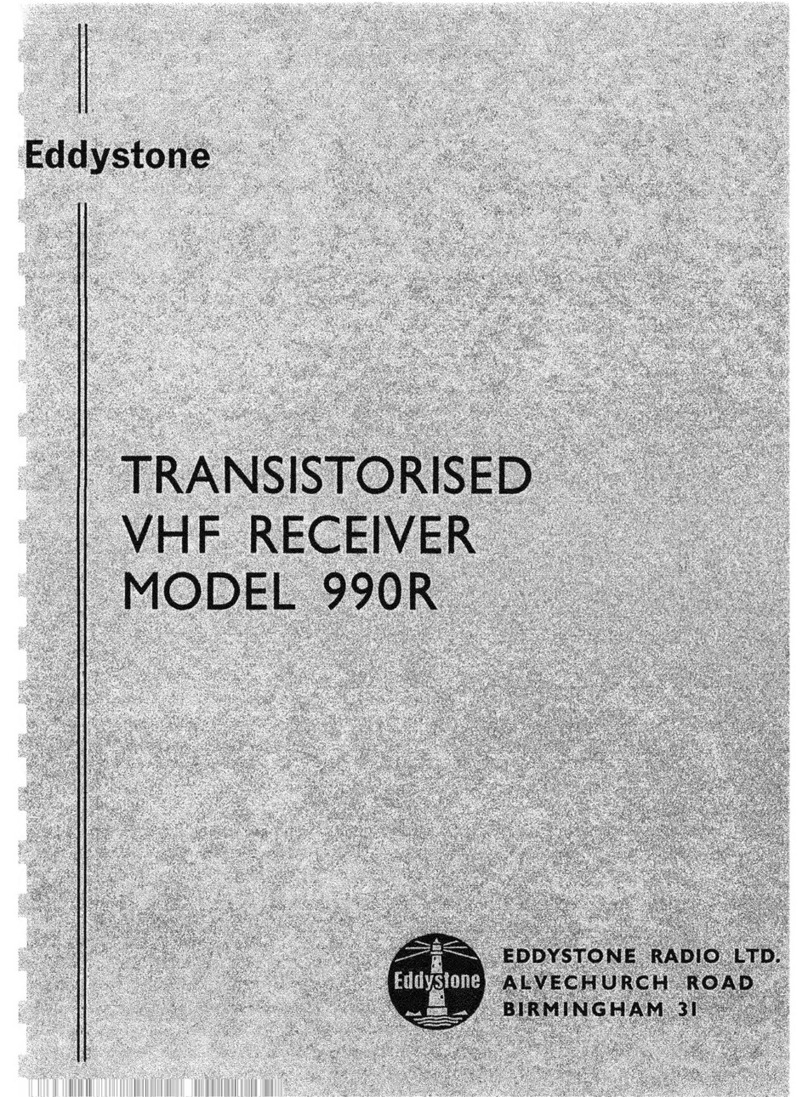
Eddystone
Eddystone 990R User manual

Eddystone
Eddystone 659 User manual

Eddystone
Eddystone 1990R/2-S User manual

Eddystone
Eddystone 680 User manual
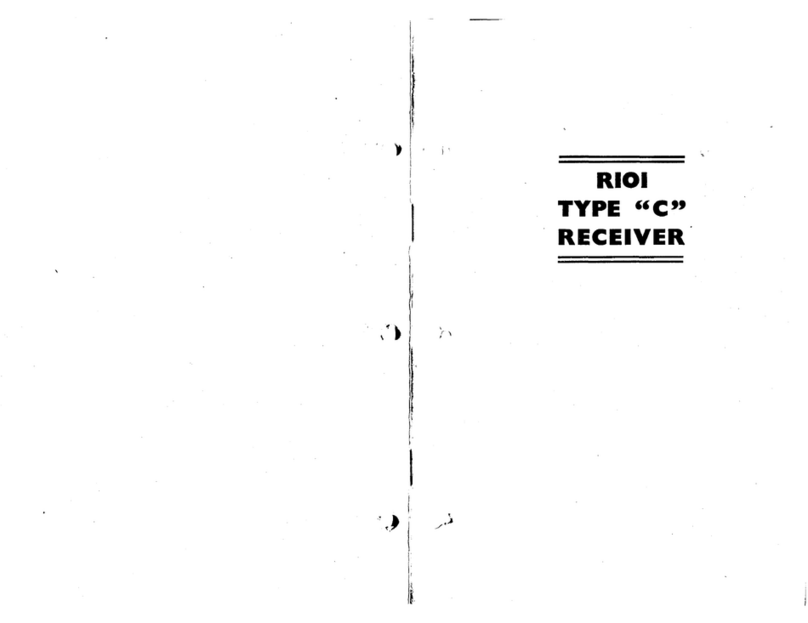
Eddystone
Eddystone R191 C User manual

Eddystone
Eddystone 6200 User manual

Eddystone
Eddystone 770R User manual
